
19
Jan
(Beyond Pesticides, January 19, 2017) The U.S. Department of Agriculture (USDA) opened a 60-public comment period January 17 on a controversial proposal to establish a federal research and promotion check-off program that has split the organic community, with many family farmers and small farm operators disagreeing with the larger organic industry groups, represented by the Organic Trade Association (OTA), on the benefits that they will derive from a mandatory payment requirement. The application to USDA for a check-off, originally submitted by OTA in 2015, has drawn sharp division on questions of benefits and cost to farmers. OTA believes that the check-off will generate resources to lift the organic market. This program is different from traditional check-off programs, which promote individual commodities. USDA oversees check-off programs under the Commodity, Promotion, Research and Information Act of 1996.
 According to OTA, the check-off creates an industry-funded promotion, research, and information program for certified organic products, whose overarching goal is to strengthen the position of certified organic products in the marketplace. OTA says this would be achieved by funding research to benefit the organic industry, improving access to information and data across the organic sector, and educating consumers about the benefits of organic, resulting in increased demand for organic products. Under the proposal, funds will be collected from certified organic farmers, handlers, and processors. The program will be led by a board of the same makeup from different geographic regions.
According to OTA, the check-off creates an industry-funded promotion, research, and information program for certified organic products, whose overarching goal is to strengthen the position of certified organic products in the marketplace. OTA says this would be achieved by funding research to benefit the organic industry, improving access to information and data across the organic sector, and educating consumers about the benefits of organic, resulting in increased demand for organic products. Under the proposal, funds will be collected from certified organic farmers, handlers, and processors. The program will be led by a board of the same makeup from different geographic regions.
The concerns of opponents, which include a diverse mix of farm and consumer organizations, are represented by the group No Organic Check-Off. The group identifies six problems with the proposed check-off system:
- This will be just another tax on farmers either directly or indirectly when processors pass the cost down.
- Want to promote the benefits of organic? You can‚Äôt in a check-off. Even something as simple and accurate as ‚ÄúOrganic is the Gold Standard,‚ÄĚ will not be allowed by USDA.
- The Check-off system is fundamentally broken for farmers ‚Äď the federally mandated check-off programs have restrictive guidelines, heavy bureaucracy, lack of accountability and cost of administration.
- Check-off programs have a history of using check-off funds inappropriately, with poor representation of farmer priorities in granting of research dollars.
- Commodity check-off programs that are successful see a decline of family farmers in business.
- Promoting organic sales now will not increase organic acreage in the US but will increase lower priced organic imports.
The proposal will be open for public comment until March 20, 2017. Submit a comment here.
According to the National Agriculture Law Center, checkoff programs ‚Äúpromote and provide research and information for a particular agricultural commodity without reference to specific producers or brands.‚ÄĚ They are referred to as ‚Äúcheck-off programs‚ÄĚ because at their inception¬†they were not mandatory and producers had to mark a check-off box to indicate that they wanted to contribute to the program. Some of the most prominent campaigns to come from these check-off programs include “Got Milk?” “Beef, It’s What’s For Dinner,” and “Behold, The Power of Cheese.”
USDA‚Äôs current rules exempt organic producers from participation in conventional check-off programs, since those promotional campaigns make no distinction concerning the quality of the product, health benefits, or methods of production that set organically produced products apart from competitors. USDA says, “Should this proposed rule become final, pursuant to section 10004 of the 2014 Farm Bill, the regulatory language currently exempting organic commodities from assessment by generic commodity promotion programs created under the various commodity promotion laws (7 U.S.C. 7401(e)) shall no longer be in effect. Such commodities would then become ‚Äúdual-covered commodities‚ÄĚ, and persons producing, handling and importing them would need to elect to pay assessments to the commodity-specific program, or the organic commodity promotion program.”
The proposed program will be funded by organic certified producers and handlers whose annual gross sales are in excess of $250,000 paying one-tenth of one percent of net organic sales, with importers paying the same percentage on the transaction value of their certified organic products reported to U.S. Customs and Border Protection upon import. Producers, handlers, and importers that fall below the $250,000 threshold could voluntarily choose to opt in to the program.
The program would also:
- Carry out the bi-partisan directive to expand and make consistent exemptions from commodity promotion programs for all certified-organic producers. Currently only “100% certified organic” producers qualify.
- Enable support of grassroots organic research and marketing.
- Allocate at least 25 percent of the funding specifically for local and regional research.
Critics say that USDA could do more to make the paperwork requirements easier for small organic producers, who should only have to register their exemption once, not annually. The program, called the Generic Research and Promotion Order for Organic, would be run by a 17 member board of directors, independent of OTA. The board would be charged with pursuing educational initiatives and promotional campaigns to help boost demand for organic products by increasing consumer awareness of the benefits of organic food, which OTA believes will benefit everyone in the organic supply chain. OTA maintains that as the demand for organic increases, due to the check-off program, more farmers will be willing to make the switch to organic, which will be crucial to match organic demand in the U.S. Consumer demand for organic in the U.S. already outpaces production. The group, No Organic Check-Off, on the other hand, says that without a plan to support increased acreage moving into organic production, consumers will see more imported organic food in the marketplace.
Critics also say that¬†check-off programs are plagued by a history of mismanagement and abuse. With so many players, there is also worry that the needs of processors and handlers could overshadow those of farmers, who John Bobbe, executive director of the Organic Famer‚Äôs Agency for Relationship Marketing¬†(OFARM), says traditionally only receive a small portion of the profit from the ever growing $40 billion organic market. Others wonder about the efficiency of marketing as a way of growing food instead of a specific commodity. ‚ÄúYou can be more flexible with your messaging and even more efficient with the dollars if you‚Äôre not tied to the government,‚ÄĚ said Harriet Behar, senior organic specialist with the¬†Midwest Organic and Sustainable Education Service¬†(MOSES).
To address the issue of meeting consumer demand for organic, OTA and USDA announced last week¬†the National Certified Transitional Program, as a partnership. This program will provide ‚ÄúCertification and oversight to producers who are in transition to organic‚ÄĚ and will include OTA working with certifiers, manufacturers, and retailers to create a ‚Äútransitional‚ÄĚ label on packaged products.
Beyond Pesticides has long promoted the importance of organic in a sustainable food system, and works to promote the widespread transition of conventional farmland to organic production. Organic law requires farmers adopt an organic systems plan to support soil biology, ecological balance, and pest prevention. Beyond Pesticides provides many opportunities to get involved inprotecting and advancing the integrity of the organic label, and encourages public action to ensure organic’s strong standards remain intact. To find out more about the work Beyond Pesticides is doing on organic integrity, check out Keeping Organic Strong, or to see all the reasons to go organic, visit Eating with a Conscience.
Source: Organic Research, Promotion, and Information Order
All unattributed positions are that of Beyond Pesticides.
Posted in Agriculture, Alternatives/Organics, Announcements, National Organic Standards Board/National Organic Program, National Politics, Take Action by: Beyond Pesticides
11 Comments
18
Jan
(Beyond Pesticides, January 18, 2017) Despite science affirming its hazards, the U.S. Environmental Protection Agency (EPA) has expanded the registration of the toxic herbicide mixture, Enlist Duo, which contains 2,4-D and glyphosate,¬†for use on genetically engineered (GE) cotton and extended its use on GE corn, soybean, and cotton from 15 to 34 states. This approval late last week comes at a time when widespread chemical use is threatening public health and the environment and weed resistance continues to grow, threatening farmers’ productivity and profitability.
Over 600 public comments were submitted to EPA on this issue, with many comments vehemently opposing the current uses and the proposed expansion of uses. In its decision, EPA stated that Enlist Duo ‚Äúmeets the safety standard for the public, agricultural workers, and non-target plants and animal species.‚ÄĚ However, as Beyond Pesticides stated in comments to the agency, EPA has not fully considered all the environmental costs, including the cost of tackling increased 2,4-D resistant weeds, crop and non-target damages from uncontrolled drift, as well as unanswered questions regarding synergistic chemical effects in non-plant species. Advocates predict weed resistance to Enlist Duo and have urged EPA to reject its continued use and incentive¬†sustainable organic practices.
Additionally, EPA made a ‚Äú’No effects‚Äô determination for species listed as threatened or endangered under the Endangered Species Act [ESA].‚ÄĚ While a new process for handling ESA consultations was outlined in 2013, EPA continues to bring pesticides to market without adequate data on a chemical‚Äôs adverse effects. EPA routinely disregards this requirement, and has been sued numerous times for failing to ensure adequate protections for endangered species.
EPA withdrew its registration approval for Enlist Duo’s use in genetically engineered (GE) crops in November 2015, following an EPA review triggered by manufacturer claims that Enlist Duo ingredients have synergistic effects, which EPA had not initially evaluated. According to EPA, its latest review of the data found no synergistic effects. However, it does not appear that assessments of exposure to both glyphosate and 2,4-D choline have been conducted to properly assess whether synergistic effects can occur in non-plant organisms.
Developed by Dow AgroSciences (Dow), Enlist Duo is an herbicide that incorporates a mix of¬†glyphosate¬†and a new¬†formulation of¬†2,4-D, intended for use on GE Enlist-Duo-tolerant corn and soybean crops. This herbicide has been marketed as a ‚Äúsolution‚ÄĚ for the control of glyphosate-resistant weeds brought on by the¬†widespread use of the chemical¬†on Roundup Ready crops over the last decade that has led to superweeds. The proposed expansion of Enlist Duo presents unreasonable adverse risks to humans and the environment.
Enlist Duo was officially registered in October 2014, and shortly after a lawsuit was filed by Beyond Pesticides and other environmental groups, challenging the approval under the Federal Insecticide, Fungicide, and Rodenticide Act. The groups argue that in its approval of Enlist Duo EPA disregarded negative impacts on sensitive species, including nearly two hundred species protected under ESA, from the increased use of the toxic cocktail on crops genetically engineered to withstand its application. In addition to environmental damage, these chemicals have been linked to a myriad of human health problems. 2,4-D has been linked to soft tissue sarcoma, non-Hodgkin’s lymphoma (NHL), neurotoxicity, kidney/liver damage, and harm to the reproductive system. Additionally, glyphosate has been classified as a human carcinogen based on laboratory studies by the World Health Organization (WHO) in March 2015.
In November 2015, EPA revoked the registration of Dow’s Enlist Duo based on new information on the toxic effects associated with the synergistic interactions of the chemical cocktail, including  2,4-D, glyphosate, and other undisclosed ingredients, to plants outside the treated area. In January 2016, the 9th U.S. Circuit Court of Appeals rejected the revocation in a three-sentence order that gave no reasoning.
A large shift in agricultural practices is necessary to ensure protection of human health and the environment over the long-term. Beyond Pesticides has long supported organic land management as a systems approach that values healthy, biologically active soils to support plant life and provide critical environmental benefits. It is through this soil based systems approach that we will eliminate toxic chemicals in land management, which have been identified as a driver in soil contamination and loss of microbial and faunal diversity.
Ecological pest management strategies, organic practices, and solutions that are not chemical-intensive are the most appropriate and long-term solution to managing unwanted plants and insects. Beyond Pesticides is working to strengthen organic farming  systems by encouraging biodiversity and holistic management practices, and upholding the spirit and values on which the organic law was founded. Underpinning the success of organic in the U.S. are small-scale producers who focus on fostering biodiversity, limiting external inputs, improving soil health, sequestering carbon, and using integrated holistic approaches to managing pests, weeds, and disease.
Sources: US EPA, Agri-Pulse
All unattributed positions and opinions in this piece are those of Beyond Pesticides.
Posted in 2,4-D, Agriculture, Announcements, Chemicals, Contamination, contamination, Corporations, Dow Chemical, Environmental Protection Agency (EPA), Genetic Engineering, Glyphosate, Pesticide Drift, Pesticide Regulation, Pesticide Residues, Resistance by: Beyond Pesticides
No Comments
17
Jan
(Beyond Pesticides, January 17, 2017) On January 12, 2017, the U.S. Environmental Protection Agency (EPA) released major risk assessment documents on ¬†pollinator exposure to bee-toxic neonicotinoid insecticides finding no significant risks, despite the large and growing body of science identifying the pesticides’ hazards. In the documents, EPA identifies risks posed to bees by several neonicotinoid insecticides, but suggests¬†that no restriction on uses are imminent. In another decision meant to protect bees from acutely toxic pesticides, the agency is scaling back its original proposal in deference chemical-intensive agricultural interests.
EPA’s¬†long awaited pollinator assessments for the neonicotinoids: clothianidin, thiamethoxam, and dinotefuran, much like the 2016¬†pollinator assessment release for imidacloprid, identifies risks to bees from the agricultural applications (foliar, soil and seed) of these chemicals, including from pesticide drift. Observed effects include decline in worker bees, and subsequent declines in brood and pollen stores in the colony. EPA‚Äės assessments continue to focus on honey bees, with cursory mention of wild, native bees. Once again, the assessments did not consider risks from exposures to contaminated water, guttation droplets, or soil, with EPA stating that, ‚ÄúThe Agency lacks information to understand the relative importance of these other routes of exposures and/or to quantify potential risks from these other routes, and as such, they are not quantitatively assessed.‚ÄĚ Similarly, contaminated dust, produced as a result of the planting of coated seeds, was acknowledged by the agency as a potential source of exposure and risk, as well as the cause of several bee kill incidents. However, once again the agency did not conduct an assessment for this exposure, citing stakeholder work on best management practices to reduce dust.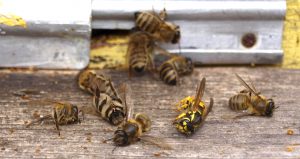
Pollen and nectar are identified as the major sources of exposure to bees from the neonicotinoids. EPA utilized a new modeling scheme to estimate environmental residues and produce its assessment. The agency also identified on-field risks for certain crops including: for clothianidin ¬†‚ÄĒcucurbit vegetables, citrus and cotton oilseed; for thiamethoxam ‚ÄĒfruits, cucurbit vegetables, citrus fruits, berry and small fruit, cotton oilseed; for dinotefuran ‚ÄĒstone fruit, cucurbit vegetables, small vine fruit, berries. EPA also released the aquatic assessment for imidacloprid, which found elevated risks to aquatic organisms. This is not surprising as scientific studies show that neonicotinoids adversely affect¬†birds, ¬†aquatic organisms and contaminate soil ¬†and ¬†waterways, and ¬†overall biodiversity.
EPA also released its final Policy to Mitigate the Acute Risk to Bees from Pesticide Products, which follows its 2015 proposal to mitigate exposure to bees from acutely toxic pesticides products. In its 2015 document, EPA proposed to restrict foliar applications of pesticides acutely toxic to bees during crop bloom and when managed bees are present. Then, EPA identified over 60 pesticides that are highly toxic to bees for spray restrictions when managed bees were on site. Beekeepers and concerned activists said then that the proposal fell short in protecting bees, especially native bees.
EPA is now scaling back its modest proposal, focusing on reducing impacts on growers. To enable growers to continue using these toxic pesticides, EPA is providing numerous exceptions, including application timing (applications can now be made two hours before sunset and eight hours before sunrise). Further, instead of targeting restrictions on pesticides that are highly acutely toxic to bees based on bee hazard data, EPA is now planning to utilize risk mitigation criteria with a focus on pesticides that have field residual times (RT25) six¬†hours or less. EPA believes this will provide growers with ‚Äúgreater flexibility‚ÄĚ to apply pesticides to crops. The agency has recommended label language:
Foliar application of this product is prohibited to a crop from onset of flowering until flowering is complete when bees are under contract for pollination services to that crop unless:
(i) the application is being made to prevent or control a threat to public and/or animal health as determined by a state, tribal, authorized local health department or vector control agency; OR
(ii) the application is being made to from 2-hours prior to sunset until sunrise; OR,
(iii) the application is being made at a time when the temperature at the
application site is 50oF or less.
Further, at the request of industry-led groups, EPA intends to go back and amend previous neonicotinoid labels that restrict applications under certain conditions with these newly recommended label statements that seem even less protective. The agency states it will begin implementing this policy in 2017 by sending letters to registrants describing steps that must be taken to incorporate the new labeling.
In both the pollinator assessments and ‚ÄúPolicy‚ÄĚ document, EPA continues to ignore the systemic impacts posed by many of these chemicals, especially the neonicotinoids, which the science has shown are extremely persistent in plants and soil and result in chronic exposures in the environment, continually endangering all pollinators that forage in treated or contaminated areas months and even years after initial application. EPA‚Äôs focus on short-term acute impacts from neonicotinoids exemplifies EPA narrow-scope of mitigation and undermines successful pollinator protection.
Systemic neonicotinoid pesticides, as a class of chemicals, move through the plants vascular system and are expressed through pollen, nectar, and guttation droplets.  These pesticides, which include imidacloprid, thiamethoxam and clothianidin, have been found by  a growing body of scientific literature  to be linked to pollinator decline in general.  Neonics are associated with decreased foraging  and navigational ability, as well as increased vulnerability to pathogens and parasites as a result of suppressed bee immune systems.
There will be a 60-day public comment period for the new neonicotinoid assessments onece the EPA’s documents are published in the Federal Register. EPA invites public comment on all of these preliminary assessments, and is especially interested in getting input from stakeholders on the new method for assessing potential exposure and risk through pollen and nectar. EPA may revise the pollinator assessment based on comments received, as well as additional data that it anticipates receiving during 2017. The final neonicotinoid risk assessments will be released for public comment by mid-2018.
In light of the shortcomings of federal action¬†to protect these beneficial organisms, it is left to advocates and consumers to ensure safe havens for pollinators by creating pesticide-free habitat and educating others to do the same.¬†Take action by calling on EPA to suspend neonicotinoids now. You can also declare your garden, yard, park or other space as pesticide-free and pollinator friendly. It does not matter how large or small your pledge is, as long as you contribute to the creation of safe pollinator habitat.¬†Sign the pledge today! Need ideas on creating the perfect pollinator habitat? The¬†Bee Protective Habitat Guide¬†¬†can tell you which native plants are right for your region. For more information¬†on what you can do, visit Beyond Pesticides’¬†BEE Protectiv¬†¬†page.
Source EPA
Posted in Agriculture, Alternatives/Organics, Chemicals, Clothianidin, contamination, dinotefuron, Environmental Protection Agency (EPA), Increased Vulnerability to Diseases from Chemical Exposure, Pesticide Regulation, Pesticide Residues, Pollinators, Take Action, Thiamethoxam by: Beyond Pesticides
No Comments
13
Jan
(Beyond Pesticides, January 13, 2016)¬†Just prior to the U.S. Environmental Protection Agency (EPA) announcement on January 12 that several neonicotinoid insecticides “do not pose significant risks to bee colonies,” the preprint version of a new review¬†of neonics identified the range of lethal and sublethal effects of the chemicals on non-target organisms. ¬†The review, The Environmental Risks of Neonicotinoid Pesticides: a review of the evidence post-2013,¬†authored by Dave Goulson, PhD, and Thomas James Wood, a PhD candidate, concludes that studies published since the 2013 European Food Safety (EFSA) published risk assessments¬†show even greater risks. The EFSA assessment, which led to a moratorium on neonicotinoid uses, found that¬†certain neonics on specific flowering crops pose a high risk to bees.
With reference to the 2013 EFSA risk assessment conclusions as their baseline, the researchers summarize the difference in risk for certain categories, including:
- ‚ÄúRisk of exposure from and uptake of neonicotinoids in non-crop plants. Uptake of neonicotinoids by non-target plants was considered likely to be negligible, though a data gap was identified. Many studies have since been published demonstrating extensive uptake of neonicotinoids and their presence in the pollen, nectar and foliage of wild plants. Exposure from non-target plants clearly represents a Greater Risk.‚ÄĚ
- ‚ÄúSublethal effects of neonicotinoids on wild bees. Consideration of sublethal effects by EFSA was limited as there is no agreed testing methodology for the assessment of such effects. Exposure to neonicotinoid-treated flowering crops has been shown to have significant negative effects on free flying wild bees under field conditions and some laboratory studies continue to demonstrate negative effects on bee foraging ability and fitness using field-realistic neonicotinoid concentrations. Greater Risk.‚ÄĚ
The review also delves into areas of study that were not considered by EFSA, such as the impact of neonicotinoids on environmental health. The researchers compile a range of risks to non-target organisms, including the death of beneficial predator populations, the persistence of neonicotinoids in soils, which leads to constant contamination and accumulation over time, to a higher sensitivity of aquatic organisms to neonicotinoids. The authors make the case that, due to this new evidence demonstrating greater risk to bees and the environment, the current moratorium on imidacloprid, clothianidin and thiamethoxam in Europe should be extended, and that the partial ban should be expanded to other neonic uses.
This review adds merit to the body of research regarding neonicotinoids and their impacts on pollinators and other non-target beneficial species. Neonicotinoids are a class of insecticides that share a common mode of action that affects the central nervous system of insects, resulting in paralysis and death. While the issue of pollinator declines is diverse and complex, with many factors potentially contributing to the cause, pesticides have consistently been implicated as a key factor, not only through immediate bee deaths, but also through sublethal exposure. Neonics are associated with decreased learning, foraging and navigational ability, as well as increased vulnerability to pathogens and parasites as a result of suppressed bee immune systems. In addition to toxicity to bees, pesticides like neonicotinoids have been shown to also adversely affect birds, aquatic organisms and contaminate soil and waterways, and overall biodiversity.
In light of the shortcomings of federal action in the U.S. to protect these beneficial organisms, it is left up to us to ensure that we provide safe havens for pollinators by creating pesticide-free habitat and educating others to do the same. Beyond Pesticides has created a small pesticide-free garden at our offices in DC to provide habitat and forage for our local pollinators, including a beehive on site. You too can pledge your green space as pesticide-free and pollinator-friendly. It does not matter how large or small your pledge is, as long as you contribute to the creation of safe pollinator habitat. Sign the pledge today. Need ideas on creating the perfect pollinator habitat? The Bee Protective Habitat Guide  can tell you which native plants are right for your region. Beyond Pesticides also advocates the adoption of organic land management practices and policies by local communities.
EPA will open a 60-day public comment period when it publishes in the Federal Register its preliminary risk assessments for clothianidin, thiamethoxam, and dinotefuranand and new method for assessing potential exposure risks through pollen and nectar.
All unattributed positions and opinions in this piece are those of Beyond Pesticides.
Source: The Environmental Risks of Neonicotinoid Pesticides: a review of the evidence post-2013
Posted in Agriculture, Chemicals, Clothianidin, Contamination, Environmental Protection Agency (EPA), Imidacloprid, Increased Vulnerability to Diseases from Chemical Exposure, International, Pesticide Regulation, Pesticide Residues, Pollinators, Thiamethoxam by: Beyond Pesticides
1 Comment
12
Jan
(Beyond Pesticides, January 12, 2017) Yesterday marked a monumental event¬†in the fight against pollinator declines, as the rusty patched bumblebee became the first bee species to officially be declared endangered by the U.S. Fish and Wildlife Service (FWS). According to FWS, endangered species designations are made when a species is ‚Äúin danger of becoming extinct throughout all or a portion of their range.‚ÄĚ Tom Melius, Service Midwest Regional Director for FWS, stated in a press release that, when it comes to this determination, ‚Äú[FWS‚Äôs] top priority is to act quickly to prevent extinction of the rusty patched bumble bee. Listing the bee as endangered will help [the agency] mobilize partners and focus resources on finding ways right now to stop the decline.‚ÄĚ Listed yesterday in the Federal Register, the ruling will go into effect February 10, 2017. This is a victory for environmental groups¬†who have fought¬†to protect the rusty patched bumble bee from widespread threats, such as habitat loss and pesticide use.
According to FWS, the rusty patched bumble bee was once widespread across the United States and parts of 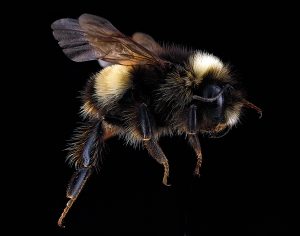 Canada, but declined dramatically in the 1990s.  Since then, their populations have dwindled and their overall decline is estimated at 91 percent. In its initial assessment, FWS acknowledged that the bumble bee populations considered for this listing have not been reconfirmed since the early 2000s, meaning that currently there may be even less of the species left. Threats to the rusty patched bumble bee include diseases introduced by commercial bumble bees that are not free of pathogens and are released near wild populations. Climate change plays a part, along with habitat loss, from industrial agriculture and development, that decreases wild lands. There is also an overwhelming amount of research demonstrating that neonicotinoid insecticides, working either individually or synergistically, play a critical role in the ongoing decline of bees and other pollinators.
Canada, but declined dramatically in the 1990s.  Since then, their populations have dwindled and their overall decline is estimated at 91 percent. In its initial assessment, FWS acknowledged that the bumble bee populations considered for this listing have not been reconfirmed since the early 2000s, meaning that currently there may be even less of the species left. Threats to the rusty patched bumble bee include diseases introduced by commercial bumble bees that are not free of pathogens and are released near wild populations. Climate change plays a part, along with habitat loss, from industrial agriculture and development, that decreases wild lands. There is also an overwhelming amount of research demonstrating that neonicotinoid insecticides, working either individually or synergistically, play a critical role in the ongoing decline of bees and other pollinators.
In FWS‚Äôs press release on the listing, Mr. Melius spoke to the species importance, stating that, ‚ÄúThe rusty patched bumble bee is among a group of pollinators ‚Äď including the monarch butterfly ‚Äď experiencing serious declines across the country. Why is this important? Pollinators are small but mighty parts of the natural mechanism that sustains us and our world. Without them, our forests, parks, meadows and shrublands, and the abundant, vibrant life they support, cannot survive, and our crops require laborious, costly pollination by hand.‚ÄĚ
A class of pesticides known as neonicotinoids have been linked as a key contributor to pollinator decline, affecting the central nervous system of insects, resulting in paralysis and eventual death. These pesticides have consistently been implicated not only through immediate bee deaths, but also through sublethal effects that causes changes in bee reproductive, navigation, and foraging function. Pesticide exposure can impair both detoxification mechanisms and immune responses, rendering bees more susceptible to viruses, parasites, and other diseases, and leading to devastating bee losses.
In 2015,¬†a study coauthored by Christopher Connolly, Ph.D., University of Dundee, found that bumble bees exposed to field-relevant levels (2.1 parts per billion) of the neonicotinoid insecticide clothianidin suffer poor navigation and foraging skills. Clothianidin exhibits an acute effect on the bumble bee‚Äôs brain, breaking down the mitochondria in its brain cells. At the time, Dr. Connolly stated, ‚ÄúOur research demonstrates beyond doubt that the level of neonicotinoids generally accepted as the average level present in the wild causes brain dysfunction and colonies to perform poorly when consumed by bumble bees.‚ÄĚ
In another study,  Seed coating with a neonicotinoid insecticide negatively affects wild bees, Swedish scientists reported that wild bees and bumble bees foraging in crops treated with a commonly used insecticide seed coating, a combination of the neonicotinoid clothianidin and the non-systemic pyrethroid β-cyfluthrin, are  less likely to reproduce when compared to bees in untreated fields, and that bumble bee colonies in treated fields gain less weight. Additionally, fewer wild bees and bumble bees are found in treated fields than in untreated ones.
While it is a victory that FWS has listed the rusty patched bumble bee as an endangered species, other agencies continue to lag behind when it comes to addressing the threat of pesticides to pollinators. In March 2016, a U.S. Government Accountability Office (GAO) report concluded that U.S. regulatory agencies are falling short in addressing the multiple threats contributing to declining pollinators. The GAO report recommends that the U.S. Department of Agriculture (USDA) increase the monitoring of wild, native bees, while U.S. Environmental Protection Agency (EPA) efforts thus far on pesticide restrictions (label amendments and restrictions) have been limited and accomplished little to change pesticide exposure patterns to pollinators. GAO identified the need for EPA to develop a plan to assess pesticide risks to a range of bee species beyond honey bees, as current EPA evaluations only use honey bees as a surrogate for wild bee species. Further, the report finds that the impact from exposure to chemical mixtures also needs to be investigated.
Similarly, in February 2016, a United Nation’s assessment of pollinators and the global food supply warned that many species of wild bees, butterflies, and other pollinators are on a dangerous path toward extinction, further threatening the food supply if the human-made causes of these declines are not halted. The assessment found that an estimated sixteen percent of vertebrate pollinators are threatened with global extinction.
For these reasons and many others, Beyond Pesticides works to promote the widespread transition of conventional farmland to organic production. Organic law requires farmers to foster soil health, and create a strategy to deal with pest populations before they become a problem. Because of these factors, many certified organic farms do not need to use organic-compatible pesticides because their required organic systems plan practices increase plant health and pest and disease resiliency through an increased diversity of pest predators.
With one in three bites of food reliant on bees, other insects, and birds for pollination, the decline in pollinators due to pesticides, and other human-made causes, demands immediate action. For more on this and what you can do to protect pollinators, visit Beyond Pesticides’ BEE Protective webpage.
For further information about the decline of the rusty patched bumble bee, you can watch A Ghost in the Making, a short film about the species disappearance.
Source: FWS, Xerces Society
All unattributed positions and opinions in this piece are those of Beyond Pesticides.
Posted in Agriculture, Alternatives/Organics, Beneficials, Biodiversity, Chemicals, Clothianidin, contamination, Cyfluthrin, Imidacloprid, Increased Vulnerability to Diseases from Chemical Exposure, Integrated and Organic Pest Management, Pesticide Regulation, Pesticide Residues, Pollinators by: Beyond Pesticides
No Comments
11
Jan
(Beyond Pesticides, January 11, 2017) Ultra-low doses of glyphosate¬†formulations fed to rats is linked to an increased likelihood of developing non-alcoholic fatty liver disease (NAFLD), according to a recently published study in the journal¬†Nature. A¬†lead author of the study, Michael Antoniou, PhD, stated that the findings are ‚Äúvery worrying as they demonstrate for the first time a causative link between an environmentally relevant level of Roundup consumption over the long-term and a serious disease.‚ÄĚ The findings point to the growing need to eliminate the widespread use of this herbicide, as it has already been implicated in endocrine disruption, reproductive effects, and kidney and liver damage.
The researchers analyzed female rat livers obtained from a previous 2-year study on Roundup toxicity using molecular profiling techniques. These rats were administered Roundup via drinking water at a concentration of 0.1 ppb, which is an allowable level within both the U.S. and the European Union. The molecular analyses conducted by researchers on the internal organs of the rats fed Roundup included testing of liver cell disturbances. Overall, ultra-low dose glyphosate-formulation exposure led to observations of biomarkers also seen in fatty liver disease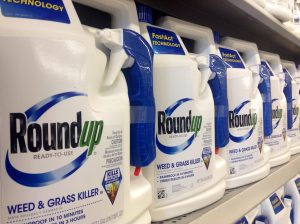 .
.
These findings have human health implications ‚Äúsince NAFLD is predicted to be the next major global epidemic,” according to the authors. They continue, “Approximately 20-30% of the population in the United States carry extra fat in their livers. NAFLD is associated with the recent rapid rise in the incidence of diabetes, obesity, and metabolic syndrome.‚ÄĚ There has also been recent research linking other endocrine disrupting chemicals with the development of metabolic syndrome, although additional studies are needed to investigate the role of chronic glyphosate exposure in the development of these risk factors.
Glyphosate, produced by Monsanto, is one of the most popular weedkillers in the U.S., and the active ingredient in Roundup. Glyphosate is often promoted by industry as a ‚Äúlow toxicity‚ÄĚ chemical and ‚Äúsafer‚ÄĚ than other chemicals, yet has been shown to have detrimental impacts¬†¬†on humans and the environment. Given its widespread use on residential and agricultural sites, its toxicity is of increasing concern.
A¬†long-awaited¬†and contentious scientific meeting convened by the U.S. Environmental Protection Agency (EPA) on the carcinogenic properties of glyphosate wrapped up its review in mid-December 2016. The¬†15-member¬†scientific advisory panel was split on their positions,¬†with some considering a ‚Äúsuggestive evidence‚ÄĚ classification. The panel‚Äôs charge was to evaluate EPA‚Äôs¬†recent proposal¬†that the widely used herbicide should be considered ‚Äúnot likely to be carcinogenic to humans,‚ÄĚ despite a 2015¬†determination from the International Agency for Research on Cancer¬†than glyphosate is ‚Äúprobably carcinogenic‚ÄĚ with ‚Äúsufficient evidence of carcinogenicity‚ÄĚ based on laboratory studies. ¬†The panel now has roughly three months to provide a final¬†recommendation to the agency, which is likely to influence EPA‚Äôs final classification of the herbicide.
Debate has also been raging in Europe about the continued use of glyphosate in light of the 2015 classification by the World Health Organization‚Äôs (WHO) International Agency for Research on Cancer (IARC) of glyphosate as a ‚Äúprobable human carcinogen.‚ÄĚ However, confusion peaked when a few short months later the European Food Safety Authority (EFSA)¬†published its report,¬†finding that glyphosate is ‚Äúunlikely to pose a carcinogenic hazard to humans.‚ÄĚ However, EFSA‚Äôs report is limited in that it reviewed glyphosate alone, unlike IARC, which reviewed glyphosate and its formulated products (Roundup) which are more relevant for evaluating risks to human health. The European Commission has since issued a limited license extension for glyphosate, after member states were unable to come to a formal decision.
In addition to IARC‚Äôs findings,¬†previous studies¬†have linked the toxicant to non-Hodgkin‚Äôs lymphoma and multiple myeloma. In September 2015, a study published in Environmental Health News found that chronic, low-dose exposure to glyphosate¬†¬†led to adverse effects on liver and kidney health. Roundup formulations can also induce a dose-dependent formation of DNA adducts (altered forms of DNA linked to chemical exposure, playing a key role in chemical carcinogenesis) in the kidneys and liver of mice. Human cell endocrine disruption on the androgen receptor, inhibition of transcriptional activities on estrogen receptors on HepG2, DNA damage and cytotoxic effects occurring at concentrations well below ‚Äúacceptable‚ÄĚ residues have all been observed. Similarly, a study released this year finds that glyphosate can cause changes to DNA function resulting in the onset of chronic disease, including diabetes, obesity, and Alzheimer‚Äôs disease.
Given the mounting evidence of glyphosate’s hazards environmental groups, like Beyond Pesticides, are urging localities to restrict or eliminate the use of the widely-used weedkiller, like Tracy Madlener, a mother of two, successfully did last year. Beyond Pesticides promotes these actions and many more through our Tools for Change page. Consumers and advocates can work to eliminate widespread glyphosate use by buying organic, as this will support an agricultural system that is not reliant on, and in fact never permits the use of glyphosate or any other toxic synthetic pesticides. You can also urge your local grocery store and garden center to stop selling glyphosate, or any product that has ever been sprayed with the chemical. Possibly the most effective move you can make is to get active in your local community. Beyond Pesticides has resources, including a newly released Map of U.S. Pesticide Reform, to help folks concerned about glyphosate take action to reduce and eliminate its use.
Sources: Nature, The Ecologist
All unattributed positions and opinions in this piece are those of Beyond Pesticides.
Posted in Agriculture, Alternatives/Organics, Chemicals, contamination, Contamination, Corporations, Disease/Health Effects, Genetic Engineering, Glyphosate, Health care, Monsanto, Pesticide Regulation, Pesticide Residues by: Beyond Pesticides
1 Comment
10
Jan
(Beyond Pesticides, January 10, 2017) Exposure to neonicotinoid (neonic) insecticides leads to a decrease in pollination frequency and fewer social interactions in bumblebees, according to research published by scientists from Harvard University and University of California, Davis. The study, released last year but presented this week at the Society for Integrative and Comparative Biology’s annual meeting, underscores the need for regulators and policy makers to eliminate use of these chemicals, not only to protect honey bees, but also wild pollinators like the bumblebee.
While worker bumblebees (Bombus impatiens) divide their tasks within the colony in a similar manner to honey bees, their nests appear quite different than their more structured cousins. “Bumblebee nests are not the organized, beautiful geometry of the honeybee,” said James Crall, PhD candidate in Harvard’s Department of Organismic and Evolutionary Biology. Instead, “They’re more a hodge-podge of food and larvae in a pile in the middle of the nest space.”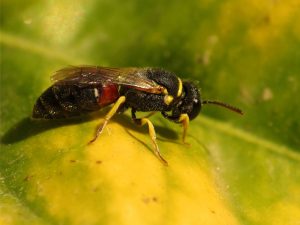
For their study, researchers placed four bumblebee colonies in a mesh enclosed area, tagged each bee, and observed them foraging on tomato flowers grown in a pollinator-excluding greenhouse (to ensure bees had freshly-opened flowers for pollination each day). After observing normal behavior, bees within each colony were then randomly assigned to ingest increasing levels of the neonic imidacloprid (0, 0.0515, 0.515, or 5.15 ng of imidacloprid, respectively). Results show that workers exposed to imidacloprid tend to move toward the outside edge of the nest and spend less time caring for their brood (young).
Pollination by individual workers is also significantly affected by imidacloprid exposure, with pollinating worker bees less likely to resume foraging after being exposed. The morphology of the tomato flower makes it nearly impossible to be successfully pollinated by honey bees. Instead, bumblebees (and certain other wild pollinators) ‚Äúsonicate,‚ÄĚ or buzz tomato plants by producing a vibration that shakes loose the plant‚Äôs pollen. But researchers found that even at low and modest doses (0.515, or 5.15¬†ng) neonic exposure makes pollination significantly less likely.
This study is simply the latest in a robust body of research showing harm to wild and native pollinators from neonicotinoid exposure. A study presented last year at the British Ecological Society’s annual meeting determined that the neonic thiamethoxam makes it more difficult for bumblebees to learn how to sonicate. Compared to a control group, neonic treated bumblebees failed to produce a strong vibration, leading to less pollen collection. The results of these collective studies help confirm research from Scottish investigators published 2015 showing that neonics harm the brain cells of bumblebees.
Scientists have shown that the effects of neonics go beyond the direct impact on pollination skills to the size of neonic-exposed bumblebee colonies. Colonies treated with the neonic clothianidin recorded fewer workers, drones, and reproductive female bees compared to colonies without exposure.
Despite the fact that wild pollinators enhance fruit set in agricultural fields and pollinate more effectively than honey bees, given the widespread and continued use of neonics, it is little wonder why studies have noted that wild pollinators are in decline. In the United Kingdom alone, researchers from the Centre for Ecology and Hydrology have linked the use of neonics to the loss of half the country’s wild pollinators.
While this data is critically important in understanding the extent of the current crisis, it is imperative that advocates use this information to press for change. At the federal level, as the Fish and Wildlife Service has eliminated neonic use at national wildlife refuges out of precaution, the U.S. Environmental Protection Agency (EPA) represents a stark contrast, doing little to address the impact of these chemicals on undervalued and unprotected wild pollinators. When EPA reviewed the neonic imidacloprid for its impacts to pollinators early last year, the agency only analyzed honey bee health, despite the thousands of other unique, and potentially endangered wild pollinators that are likely to come into contact with these poisons.
Though disquieting for researchers and advocates alike, the fact is that EPA’s decisions are made with considerations beyond the science at hand. In determining whether to restrict a chemical, public input weighs heavily. For those who support pollinator health and want to influence federal decisions on this issue, the best way to increase the pressure is to get active in your local community. Work to pass pesticide policies that protect both honey bees and wild pollinators, as numerous communities (see yellow boxes) have done. For assistance, contact Beyond Pesticides at [email protected].
More information on protecting wild pollinators where they forage can be found on Beyond Pesticides’ Managing Landscapes with Pollinators in Mind webpage. Also stay tuned to Beyond Pesticides’ new monthly series PolliNATION, which aims to celebrate our less known, but critically important wild pollinators.
Source: Phys.org
All unattributed positions and opinions in this piece are those of Beyond Pesticides.
Posted in Agriculture, Alternatives/Organics, Biodiversity, Chemicals, Environmental Protection Agency (EPA), Hydroponics, Imidacloprid, Increased Vulnerability to Diseases from Chemical Exposure, National Politics, Pesticide Drift, Pesticide Regulation, Pesticide Residues, Pollinators by: Beyond Pesticides
1 Comment
09
Jan
(Beyond Pesticides,¬†January 9, 2017) After the U.S. Environmental Protection Agency (EPA) released its recent human health risk assessment for the organophosphate insecticide (OP) tetrachlorvinphos (TCVP) on December 21, 2016, the agency announced it was allowing the continued use of the neurotoxic chemical to which children are widely exposed through pets’ flea collars and other flea treatments. According to EPA, ”¬†TCVP is used as a direct animal treatment to livestock (i.e., cattle, horses, poultry and swine) and their premises, in kennels, outdoors as a perimeter treatment, and as a flea treatment [including flea collars] on cats and dogs.”
In its announcement on January 4, 2017, EPA states, “We advise consumers to take certain precautions when handling TCVP products in residential areas. These precautions are listed on TCVP product labels, including: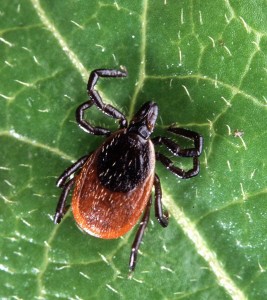
- not allowing children to play with TCVP pet collar products,
- keeping TCVP spray and powder products out of reach of children, and
- washing hands thoroughly with soap and water after handling.”
Advocates have raised concerns related to similar decisions on flea collars in the past in which EPA has issued warnings to mitigate risks, despite its inability to ensure children’s safety. Children typically come into close contact with pets and their flea collars that cannot be controlled by the type of warning EPA is issuing. Additionally, there is ongoing concern that low level volatility in the home from treated pets in close proximity to family members represents an unacceptable hazard to a neurotoxic pesticide.
TCVP, like other organophosphates, works by inhibiting the enzyme acetylcholinterase. The inhibition leads to the accumulation of acetylcholine and ultimately toxicity to the central and peripheral nervous system. Organophosphates are nerve poisons that cause numbness, tremors, nausea, incoordination, blurred vision, difficulty breathing or respiratory depression, and slow heartbeat. TCVP, while most commonly found in fleas and tick control collars for pets, is used orally and dermally on livestock for flea and tick control. It is formulated in a variety of ways, including dusts, powders, and liquid sprays. Aside from coming into contact with a pet wearing a flea or tick collar, people can be exposed to TCVP via food and water and, as a result of this livestock use, EPA has determined that there is dietary exposure to people. There are also numerous occupational risks of exposure, affecting applicators, veterinarians, pet groomers, and livestock caretakers.
In its review, EPA acknowledges that it does not have all the all the data it needs to assess the affect of exposure to the pesticide on children and therefore has applied an additional 10x margin of safety factor. Advocates have disputed the decision to allow children’s exposure when the data on TCVP’s effects is not complete. EPA said, “For TCVP, as for other OPs, the FQPA safety factor (SF) of 10X has been retained for infants, children, youths, and women of childbearing age for all exposure scenarios due to uncertainty in the human dose-response relationship for neurodevelopmental effects.”This approach to regulating pesticides rejects the precautionary principle, which eliminates use until complete data is available.
The agency review respondt to a 2009 petition filed by Natural Resource Defense Council.  The assessment was finalized by the Health Effects Division (HED) of the EPA as requested by the Office of Pesticide Programs Pesticides Re-evaluation Division. TCVP is a common active ingredient in tick and flea control pet collars, and is part of a class of insecticides called organophosphates, which attack the nervous system.
The previous human health risk assessment was completed in December 2015. The finalized risk assessment reflects a few updates since the 2015 risk assessment. According to EPA, the finalized risk assessment identified risks to people that exceed EPA’s level of concern. These groups include adults and children in residential settings who are exposed to dusts/powder products and pet collars, and workers applying TCVP. One of the more important points of the risk assessment included a reduction of the oral toxicological point of departure (POD) from 8.0 mg/kg/day to 2.8 mg/kg/day. More simply put, researchers identified that, in experiments with rats, observed negative effects from exposure to TCVP occurred at lower doses than previously recorded.
In 2015, the California Environmental Protection Agency’s Office of Environmental Health Hazard Assessment (OEHHA) announced that it intended to list TCVP and two other organophosphate insecticides as cancer-causing chemicals under California’s  Safe Drinking Water and Toxic Enforcement Act of 1986 (Proposition 65). If a chemical is listed under Proposition 65, businesses that use this chemical are required by law to inform consumers about potential exposure.
Children face unique hazards from pesticide exposure. They take in more pesticides relative to their body weight than adults in the food they eat and air they breathe. Their developing organ systems often make them more sensitive to toxic exposure.  The probability of an effect such as cancer, which requires a period of time to develop after exposure, is enhanced if exposure occurs early in life.
The National Academy of Sciences reports that children are more susceptible to chemicals than adults and estimates that 50% of lifetime pesticide exposure occurs during the first five years of life.  The World Health Organization (WHO) cites that over 30% of the global burden of disease in children can be attributed to environmental factors, including pesticides.
While it is important to keep pets and home free of fleas and ticks, Beyond Pesticides recommends talking to your veterinarian about treatment options and asking questions about poisoning incidents associated with any product she or he recommends. Aside from pesticides, pet owners should vacuum daily during flea season with a strong vacuum cleaner, changing the bag often; groom pets with a flea comb daily, using soapy water to dunk and clean the comb between strokes; bathe pets frequently with soap and water; and, restrict pets to a single bed and wash bedding frequently to kill larvae. If you choose to use a flea and tick product on your pet, have it applied by your veterinarian and monitor pets for any signs of an adverse reaction after application. For more information on protecting your pet, read Beyond Pesticides factsheet, Pesticides and Pets: What you should know to keep your pets safe.Also see Beyond Pesticides’ factsheets, Least-Toxic Control of Fleas and Least-Toxic Control of Ticks.
Source: Final Occupational and Residential Exposure Assessment for Registration Review
All unattributed positions and opinions in this piece are those of Beyond Pesticides.
Posted in Announcements, Chemicals, Children/Schools, contamination, Disease/Health Effects, Environmental Protection Agency (EPA), Nervous System Effects, organophosphate, Pesticide Regulation, Pesticide Residues, Pets by: Beyond Pesticides
No Comments
06
Jan
(Beyond Pesticides, January 6, 2017) When it comes to pollination, bees tend to get all of the buzz. While they are crucial to pollinating many crops, it is important to note that bees aren’t the only pollinators working hard to provide the ecosystem services we rely on to support our food system. In fact, one out of every three bites of food we take is made possible by pollinators. In order to raise awareness for the unsung pollinator heroes all around us, Beyond Pesticides created the Polli-NATION Campaign, which highlights the important work of a relatively unknown pollinator each month. With it, we will raise public awareness about these pollinators, their contribution to plant health and productivity and the preservation of natural resources, and the threats they face in their daily lives, including toxic pesticides and habitat loss.
Polli-NATION members include species like butterflies, wasps, flies, beetles, birds, bats, and more. By taking the time to read about our featured Polli-NATION pollinator, you will not only learn about the many diverse species we call pollinators, but also discover what you can do in your daily life to help ensure their survival.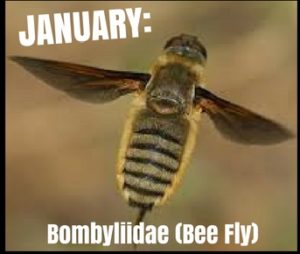
Our pollinator of the month is the bee fly! Over 5,000 species of Bombyliidae (Bee Flies), a large family within the order Diptera, can be found across the globe. While few of these species have been researched in great depth, they all have similarities that tie them to their classification. The vast majority of Bee Fly species have larvae that are parasitoids, and all adults feed on a diet of pollen and/or nectar, making them important pollinators.
Range
Bee Flies have been discovered on every continent but Antarctica. The most diverse group of species can be found in semi-arid and arid (desert) environments such as western North America, southern parts of South America, along the equatorial lines of Africa, and the mid latitudes of Eurasia.
Diet and Pollination
Most Bee Flies in their larval stage are parasitoids to the larvae of other soil-inhabiting insects. As opposed to parasites, which usually live off their host, but do not always cause death, parasitoids like the Bee Fly always kill their host. According to the World Catalog of Bee Flies, larvae of some Bombyliidae species prey on major agricultural pests, such as locusts, grasshoppers, armyworms, slugs, and caterpillars. However, select species have been found to be parasitoids of other pollinators like solitary bumblebees. And a small number species of Bee Fly larvae simply prey on insect eggs.
Most adult Bee Flies, once fully mature, feed on nectar from a variety of native flowering plants. Females are required to consume pollen in order to provide the protein and nourishment necessary for the development of eggs and reproduction. Bee Flies are thought to be responsible for what are called ‚Äúpollination syndromes,‚ÄĚ meaning many native flowering plants coevolved and adapted with Bee Flies.
Physiology
Adult Bee Flies are adapted for a pollen and nectar diet, and their physiology shows it. They have small bodies which range in length from 1mm to 2.5cm, depending on the species. Their wingspan can be as small as 1.5mm, though larger species can have a span of more than 60mm.  Many species utilize biomimicry, in terms of their coloration, often resembling bees (hence their common name as the Bee Fly) or wasps. This offers them protection, as their predators assume that they have the temperament of a more aggressive species. Nonetheless, some species simply have a solid coloration of grey or rusted brown. Bee Flies’ wings appear swept back when at rest, and their legs are generally long and skinny compared to their body, with bristles at the ends. Many Bee flies are equipped with a very long proboscis (tubes that enable them to lap up nectar) that allows them to collect nectar from flowers with long narrow floral tubes. The Bee Flies’ proboscis is fixed, and cannot be retracted, giving it a tusk-like resemblance.
Ecological Role
Bee flies play an important ecological role as pollinators, particularly for flowering desert plants in the U.S. Southwest. Although the Bombyliidae family is understudied, the World Catalog of Bee Flies notes that because many flowering plants require Bee Fly pollination in order to propagate, some endangered plant species are likely reliant on the conservation of certain bee fly species. In addition to providing valuable pollinator services as adults, as noted earlier, Bee Fly larvae can play an important role in pest control. In addition to controlling agricultural pests like slugs and locusts, some species prey on the tste fly, which are infamous for their ability to transmit human diseases like trypanosomiasis, or sleeping sickness.
Threats to Existence
A literature review by the Bureau of Land Management (BLM) notes, ‚ÄúAt any single locality a population of bee flies may be considered to be endangered, but throughout the desert areas they may not appear to be so because of their apparent wide distribution.‚ÄĚ Because their interaction between specific flowers and certain Bee Fly species is so closely intertwined, habitat loss represents a significant threat to the Bombyliidae family. BLM‚Äôs literature review provides an example of the importance of maintaining habitat in the Algodones Dunes near Imperial County, CA. Areas open to recreational vehicles like ATVs resulted in the loss of a majority of flowering plants. While Bee Fly numbers in these areas became locally extinct, areas adjacent to the recreational area maintained their population numbers.
Pesticides, particularly persistent, systemic neonicotonoid insecticides, also represent a serious threat to many Bombyliidae species. Because many species feed on agricultural pests, they are more likely to be exposed to pesticides in these areas. Although the impacts of neonicotinoids and other pesticides on wild pollinator species are understudied when compared to investigations on honey bees, research that has been performed is cause for concern.
How to Protect the Species
There are a few simple ways to protect Bee Fly populations. Providing habitat by planting native flowers is an important first step for Bombyliidae conservation. Providing native habitat is especially important for individuals in arid or semi-arid regions of the U.S. Southwest, and these flowers are relatively easy to maintain as they do not require a lot of water and there is plentiful sun.
It is also critical to avoid planting any seeds or flowers that may be coated in pollinator-toxic neonicotinoids, as these chemicals can undermine your intent to provide forage and habitat for wild pollinators. See Beyond Pesticides’ Pollinator Friendly Seed and Nursery Directory as a starting place. And for more information, see the webpage on Managing Landscapes with Pollinators in Mind. You can also get active in your community to protect these pollinators by holding native planting days in the spring, and advocating for changes to community pesticide policies. Lastly, by buying organic, you can support an agricultural system that eschews the use of toxic pesticides like neonicotinoids that harm native pollinators.
For more information on how you can get involved in pollinator conservation throughout the nation, see Beyond Pesticides BEE Protective webpage.
For citations on this information, see our Polli-NATION webpage.
Posted in Agriculture, Announcements, Chemicals, Grasshoppers, Habitat Protection, neonicotinoids, Pesticide Residues, Pests, Pollinators by: Beyond Pesticides
No Comments
05
Jan
(Beyond Pesticides, January 5, 2017) Winegrowers in the Texas High Plains region are concerned that approval of new herbicides by the U.S. Environmental Protection Agency (EPA) will devastate their profitable industry due to chemical damage from pesticide drift. Wine producers in this region of Texas have witnessed chemical damage to their vineyards that they blame on the toxic herbicides, dicamba and 2,4-D, used on cereal crops and pastures on surrounding agricultural land. A new herbicide formulation containing dicamba, XtendiMax with VaporGrip Technology, was approved by EPA, and the agency has recently proposed to register and expand the use of Enlist Duo, a herbicide that contains 2,4-D. EPA’s final decision on registration of Enlist Duo is expected in early 2017.
According to Paul Bonarrigo, owner of Messina Hof Winery in Texas, the ‚Äúapproval of these formulations will wind up affecting every vineyard up there.‚ÄĚ This will have ramifications across Texas, as the wine industry contributed $1.88 billion to the state‚Äôs economy in 2013. Advocates say that the new herbicide formulations present unreasonable adverse risks to humans and the environment in addition to harming the livelihood of farmers.
Following on these concerns, Garrett Irwin, owner of Cerro Santo vineyard, stated,‚ÄúIf we get the levels of damage that I‚Äôm afraid we‚Äôll get, vineyards will not be able to recover or produce grapes at any sustainable level, and we‚Äôre just going to have to go away.‚ÄĚ
The recently registered formulation of dicamba, XtendiMax with VaporGrip Technology, developed by Monsanto, is used in the production of genetically engineered (GE) cotton and soybean crops. Dicamba has been linked to kidney and liver damage, neurotoxicity, and developmental impacts, and has been at the center of many recent controversies. In August, farmers in Missouri, Arkansas, and Tennessee confronted widespread crop damage and braced for lower yields as a result of agrichemical giant Monsanto’s botched roll-out of GE soybean and cotton crops. The company, whose herbicide glyphosate (Roundup) is failing to control weeds in its glyphosate-tolerant crops throughout the U.S. and across the globe, developed a new line of soybean and cotton with traits that make it tolerate applications of dicamba. In October, EPA launched a criminal investigation at several locations in Missouri into the illegal spraying of dicamba, which resulted in drift and off-site damages.
Developed by Dow AgroSciences (Dow), Enlist Duo is an herbicide that incorporates a mix of¬†glyphosate¬†and a new¬†formulation of¬†2,4-D, intended for use on GE Enlist-Duo-tolerant corn and soybean crops. In addition to Enlist Duo‚Äôs widespread use on corn and soybeans, EPA has proposed extending its use on GE-cotton and expanding its approval to 19 additional states. This herbicide has been marketed as a ‚Äúsolution‚ÄĚ for the control of glyphosate-resistant weeds brought on by the¬†widespread use of the chemical¬†on Roundup Ready crops over the last decade that has led to super-weeds.
But even if farmers using these toxic herbicides follow the label instructions, there is high likelihood of drift from changing wind direction or speed, and temperature or humidity fluctuations. Claims of Enlist Duo‚Äôs lower volatility has limited application to field realities, given different environmental and application variables that play a part in whether the chemical will remain on site or travel off site. And, according to Garrett Irwin, ‚ÄúComplaints about drift damage from off-label spraying filed with the department are fruitless. The department usually responds to complaints by sending a field expert to assess the damage and interview neighbors about the herbicides they use, but neighbors who unlawfully spray are almost never investigated.‚ÄĚ
The problem facing Texan winegrowers is not unique to grapes. Pesticide drift is an inevitable problem of pesticide application, and drift and subsequent crop injury to broadleaf crops has been a frequent problem. Abnormal leaf growth, floral development, reduced yield, and reduced quality have all been observed from dicamba drift in particular. A¬†study published by Pennsylvania State scientists¬†in late 2015 found dicamba drift was ‚Äúfrequently responsible for sublethal, off-target damage‚ÄĚ to plants and insects. Historically, to mitigate against potential risks from pesticide drift, EPA has required buffer zones and application restrictions. However, these have not been sufficient to alleviate off-site crop damage and environmental contamination. Additionally, as demonstrated with these incidents, there are challenges with pesticide product label compliance and enforcement.
Beyond Pesticides has long advocated a regulatory approach that prohibits hazardous chemical use and requires alternative assessments to identify less toxic practices and products under the unreasonable adverse effects clause of the Federal Insecticide, Fungicide and Rodenticide Act (FIFRA). Farm, beekeeper, and environmental groups, including Beyond Pesticides, have urged EPA to follow in the steps of countries like Canada and the European Union by following the precautionary principle, which generally approves products after they have been assessed for harm, not before. Beyond Pesticides suggests an approach that rejects uses and exposures deemed acceptable under risk assessment calculations, and instead focuses on safer alternatives that are proven effective, such as organic agriculture, which prohibits the use of toxic chemicals. By strengthening on-farm resources, such as soil fertility, pasture and biodiversity, organic farmers can minimize and even avoid the production challenges that most genetically engineered organisms have been falsely-marketed as solving.
Sources: Texas Tribune, Rivard Report
All unattributed positions and opinions in this piece are those of Beyond Pesticides.
Posted in 2,4-D, Agriculture, Alternatives/Organics, Announcements, Chemicals, Contamination, contamination, Corporations, Dicamba, Disease/Health Effects, Dow Chemical, Environmental Protection Agency (EPA), Genetic Engineering, Glyphosate, Kidney failure, Liver failure, Monsanto, Pesticide Drift, Pesticide Residues, Resistance, State/Local, Texas by: Beyond Pesticides
No Comments
04
Jan
(Beyond Pesticides, January 4, 2017) The New Year saw its first pesticide-related tragedy yesterday when four children, ranging in age from 7-17, died from a toxic pesticide treatment on their house in Amarillo, Texas. The pesticide at issue, aluminum phosphide, was illegally applied under a mobile home where at least ten people were living. The chemical, classified by the U.S. Environmental Protection Agency (EPA) as a restricted use pesticide (RUP), is restricted for use by certified applicators (and those under their supervision) and it is a violation to use it within 100 feet of residential structures. CNN reports that a family member used water to try and wash away the pesticide after it was applied, and the combination of water and aluminum phosphide increased the release of toxic phosphine gas.
The incident demonstrates the deficiency of managing risks of highly toxic chemicals by labeling them ‚Äúrestricted use.‚Ä̬†It has been Beyond Pesticides’ position that chemicals with aluminum phosphide’s level of toxicity should not be available on the market, even with restrictions. In making regulatory determinations on pesticide allowances, advocates have urged EPA to calculate the reality of misuse and accidents, instead of assuming 100% compliance with product label instructions. With this approach, the agency would not register pesticides as highly toxic as aluminum phosphide. Similarly, Beyond Pesticides has argued that the registration of chemicals like aluminum phosphide is “unreasonable” under the Federal Insecticide, Fungicide and Rodenticide Act (FIFRA), given the availability of alternative methods and products for rodent control.
FIFRA allows EPA to register a pesticide that ‚Äúwhen applied in accordance with its directions for use, warnings and cautions and for the uses for which it is registered, or for one or more of such uses, or in accordance with a widespread and commonly recognized practice, may generally cause, without additional regulatory restrictions, unreasonable adverse effects on the environment‚ÄĚ ‚Äďif it classifies the pesticide as ‚Äúrestricted use.‚ÄĚ RUPs may be legally used only by certified applicators or someone acting under the direct supervision of a certified applicator. Although certified commercial applicators must demonstrate proficiency, certified private applicators may only be required to attend training.
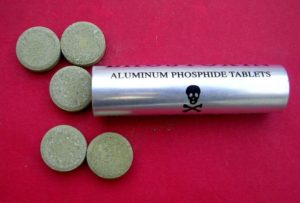
First responders arrived at the home after receiving a call that many members of the family had fallen ill, but by the time they arrived it was too late for the children, as one was dead at the scene and the three others died shortly after being rushed to the hospital. Children generally are more susceptible to chemical exposure than adults because they take in more pesticides relative to their body weight and have developing organ systems that are more vulnerable and less able to detoxify toxic chemicals. In 2010, two young girls aged 4 and 18 months died in Utah after being exposed to the same poisonous gas when aluminum phosphide was used on their lawn to treat a rat infestation. For more information on how pesticide exposure can affect children more acutely than adults, see our fact sheet Children and Pesticides Don’t Mix. The incident is currently being reported as an accidental poisoning.
Aluminum phosphide and other phosphide fumigants are known to be highly acutely toxic when ingested or inhaled, and aluminum phosphide is listed by the Environmental Protection Agency (EPA) in the Toxicity Category I, which is the highest and most toxic category. Symptoms of mild to moderate acute exposure include nausea, abdominal pain, tightness in chest, excitement, restlessness, agitation and chills. Symptoms of more severe exposure include, diarrhea, cyanosis, difficulty breathing, pulmonary edema, respiratory failure, tachycardia (rapid pulse) and hypotension (low blood pressure), dizziness and/or death. Aluminum and magnesium phosphide fumigants are used primarily to control insects in stored grain and other agricultural commodities. They also are used to control burrowing rodents in outdoor agricultural and other non-domestic areas. The fumigants are restricted to use by specially trained pesticide applicators.
In recent years, EPA has taken steps to try and address the clearly inadequate regulations regarding phosphide fumigants, but the recent death of these four children indicates that they need to revisit the current rules. In 2010, EPA imposed new restrictions on aluminum and magnesium phosphide products in an attempt to better protect people, especially children, from dangerous exposures. The restrictions prohibit, by requiring it be included on product labels, all uses of the products around residential areas and increase buffer zones for treatment around non-residential buildings that could be occupied by people or animals from 15 feet to 100 feet. However, the latest incident raises concerns about the adequacy of the pesticide’s label restrictions to actually protect human lives, and the enforceability of the rules when violations occur.
Beyond Pesticides advocates defined integrated pest management (IPM) for structural pest prevention and the utilization of non-toxic methods to manage rodents. If defined clearly, IPM eliminates toxic pesticide use and exposure to any toxic products. Sanitation, structural repairs, mechanical and biological control, pest population monitoring, and occupant education on eliminating pest conducive conditions are some IPM methods that prevent or control rodents and insects.
EPA recognizes that the use of toxic chemicals to control rodents is itself not effective rodent management. IPM practices are recommended by EPA for rodent control in and around households. EPA advises that effective rodent control requires sanitation, rodent proofing, and removal of rodent harborage, habitat modification to make an area less attractive to rodents, and discourage new populations from recolonizing the area. Non-chemical devices such as snap traps and other trapping systems are also affordable and quite effective as a method for rodent control.
However, while EPA recognizes that IPM practices are safe and effective methods for controlling rodents, the dependency on the rodenticides as a means of control continues. Given that EPA acknowledges that effective rodent management will not be achieved without the adoption of safer IPM techniques, it is imperative that these practices are promoted to the consumer so that efforts can work toward the elimination of public and environmental exposures to low levels of toxic rodenticides. To do this, rodenticide labels must require the users to establish IPM practices and only allow the introduction of poisons as a part of this approach as a last resort.
For more information on rodenticides and the alternatives to managing rodents, see Beyond Pesticides fact sheet ‚ÄúRodents Teach Lesson of Failed Chemical Controls: City officials gather to learn¬†new approaches to rodent management¬†less dependent on chemicals, more focused on habitat reduction.‚ÄĚ For¬†least toxic control of mice and other pests¬†visit Beyond Pesticides‚Äô alternatives page.
Source: CNN
All unattributed positions are that of Beyond Pesticides.
Posted in Alternatives/Organics, aluminum phosphide, Announcements, Chemicals, Disease/Health Effects, Environmental Protection Agency (EPA), Integrated and Organic Pest Management, Label Claims, Pesticide Regulation, Pests, Rodenticide, Rodents by: Beyond Pesticides
1 Comment
03
Jan
(Beyond Pesticides, January 3, 2017)  A study published in December 2016 in Environmental Contamination and Toxicology, entitled The Effect of Atrazine on Louisiana Gulf Coast Estuarine Phytoplankton, finds that phytoplankton in estuaries in close proximity to agricultural operations are less productive than phytoplankton in an uncontaminated environment. The study examines three different estuaries of the Mississippi river in Louisiana and also evaluates microcosms with different concentrations of atrazine. Phytoplankton, incredibly important to estuary ecosystems and aquatic life, are an integral part of the aquatic food web and ultimately critical to the wild seafood market. As photosynthetic microorganisms, phytoplankton harness the sun’s energy for metabolism and create as a byproduct of photosynthesis dissolved oxygen, which oxygen-breathing sea life require.
For the study, the researchers created microcosms, or large containers that are able to closely mimic ecosystems, so that they can observe the effects of independent variables. On average, phytoplankton in the microcosms are less productive at producing chlorophyll a in the presence of atrazine. The microcosm study design is important because it is difficult to separate and measure the effects of chemicals like atrazine in the environment, given the range of potential causes of phytoplankton decline. A variety of factors, like freshwater discharge rates, precipitation, and seasonal changes, make it difficult to adequately measure the variables that affect phytoplankton populations. The researchers call for a long-term study to gain a greater understanding of the scope of the atrazine contamination problem. The ongoing concern of the researchers is driven by the fact that the herbicidal properties of atrazine could have similar effects on phytoplankton as it does on terrestrial plants, since they both rely on photosynthesis for metabolism.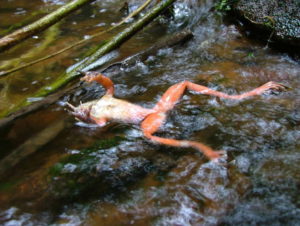
Atrazine is the second-most widely used pesticide in the United States, with over 73 million pounds applied to agricultural fields each year. Once applied to farms, precipitation and other factors cause the chemical to runoff into surrounding streams and groundwater aquifers. In 2012, water utilities settled a class action lawsuit against the manufacturer of atrazine, Syngenta, to clean up atrazine contamination of its treated water.
Even at levels established as ‚Äúsafe‚ÄĚ or acceptable by EPA drinking water standards, atrazine is linked to endocrine-disrupting effects. EPA is not adequately assessing the effects of atrazine by using high dose testing models, which are not appropriate for hormonally-active substances that often show effects at minute doses of endocrine disruptors.¬†Studies by Tyrone Hayes, Ph.D., University of California, Berkeley, ¬†and others have shown that concentrations as little as 0.1ppb impact hormone function in organisms and turns tadpoles into hermaphrodites ‚ÄĒ organisms ¬†with both male and female sexual characteristics. Research also finds that atrazine interferes with mammary gland development in the breast of mammals and is¬†linked to certain birth defects¬†¬†like gastroschisis and choanal atresia, which are significantly increased for pregnant women with high levels of atrazine exposure in agricultural areas and from urban streams.¬†The European Union and many countries have banned atrazine, however EPA continues to put U.S. citizens and the environment in harm‚Äôs way, allowing nonstop use of this toxic chemical.
in April 2016, EPA¬†released a draft ecological risk assessmen that finds atrazine poses unacceptable risks¬†¬†to fish, amphibians, aquatic invertebrates, and even birds, reptiles and mammals. The assessments evaluated risks to animals and plants, including amphibians, birds, mammals, fish, reptiles, aquatic invertebrates, aquatic plant communities, and terrestrial plants. EPA concludes, ‚Äúaquatic plant communities are impacted in many areas where atrazine use is heaviest, and there is potential chronic risks to fish, amphibians, and aquatic invertebrate in these same locations. In the terrestrial environment, there are risk concerns for mammals, birds, reptiles, plants and plant communities across the country for many of the atrazine uses.‚Ä̬†Levels of concerns were exceeded by as much as 200-fold for some organisms!
The phytoplankton study is another reminder that atrazine is proven to have an effect on aquatic ecosystems. In July 2016, California’s Office of Environmental Health Hazard Assessment (OEHHA) announced that atrazine, its chemical cousins propazine and simazine, and its breakdown triazine compounds would be added to the list of chemicals known to the state to cause reproductive toxicity for purposes of the state’s Proposition 65.
The evidence is clear. Atrazine harms wildlife, persists in soils, and moves easily through waterways. Take Action: Sign the petition to urge EPA to end the use of atrazine. In order to protect human and ecological health, the agency should take immediate action to eliminate this chemical from our environment!
Source: The Effect of Atrazine of Effect of atrazine on Louisiana Gulf Coast Estuarine Phytoplankton
Posted in Agriculture, Alternatives/Organics, Announcements, Atrazine, Chemicals, Contamination, Environmental Protection Agency (EPA), Lawns/Landscapes, Louisiana, Pesticide Regulation, Pesticide Residues, Pollinators, State/Local, Water Regulation, Wildlife/Endangered Sp. by: Beyond Pesticides
No Comments
24
Dec
(Beyond Pesticides, December 24, 2016) Beyond Pesticides thanks our members and supporters for being a part of a critical movement to advance sustainable and organic land and building management in 2016. As our Daily News takes a holiday break, returning Tuesday, January 3, 2017, we hope you will join us in reflecting on the progress made this year, and the critical challenges that lie ahead.
The road ahead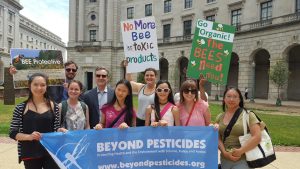
We are entering a period in our nation’s history with many serious concerns about the protection of public health and the environment. We have heard the President-elect’s rhetoric about the overreach of the Environmental Protection Agency (EPA), the burden of regulatory compliance, and the need to dismantle environmental programs. The nominee for EPA Administrator is on record as challenging science and the value of environmental protection.
In contrast, we have learned over the last several decades that protection of the environment contributes to a productive economy and healthier people. Beyond Pesticides‚Äô databases track the scientific literature on pesticide hazards and alternatives, which clearly document the value of healthy ecosystems in providing ecosystem services that translate to reduced costs for farmers and land managers. Whether we‚Äôre talking about bees and other pollinators or predator insects, healthy ecosystems are critical to a sustainable future¬† ‚Äďour future.
This year‚Äôs election occurred in the midst of a societal shift to organic land management systems that protect our air, water, land, and reduce the threat of global climate change, while producing safe food in safe workplaces. Beyond Pesticides is a critical part of the progress we have made to create an over $40 billion organic sector, showing that the toxic chemicals that are deemed ‚Äúacceptable‚ÄĚ in our water, air, soil, food, and community parks and schoolyards are not necessary. With your support, we will build this wave of change from community to community, effecting an exponential shift away from toxic chemical use and a growing organic marketplace, regardless of a government controlled by corporate interests that seek to push toxic pesticide dependency. Our unique programs of community information assistance and hands-on training make the difference in the adoption of effective land and building management programs that eliminate pesticides.
Leading the way
Beyond Pesticides is leading the nation in stopping all hazardous pesticide use with on-the-ground practices. We were reminded of the importance of Beyond Pesticides‚Äô program, which supports local action to protect community and environmental health, when U.S. EPA Administrator Gina McCarthy spoke to the Montgomery County (Maryland) Green Festival in April and told the packed auditorium that, ‚ÄúWhat happens in Montgomery County does not stay in Montgomery County.‚ÄĚ She basically told the crowd that she couldn‚Äôt do anything unless it happened at the local level first. ‚ÄúAnything that manages to make the slow crawl to Capitol Hill has made it because it has had such fertile ground in our communities. . .Nothing makes its way there that‚Äôs a great idea, that‚Äôs really creative, and that has an opportunity to make a lasting impact unless it has been proven, time and time again, at the local level. . .then it makes its way up to the state when people are obnoxious and going to demand additional action, and so on and so on. So I have to congratulate you. . .‚ÄĚ While she may not have been speaking directly to Takoma Park‚Äôs cosmetic lawn care chemical ban, followed by Montgomery County‚Äôs landmark ban, she could have been, along with the other local ordinances across the country that have been passed to protect health and the environment.
This year we’ve seen the continuation of local policies that illustrate misguided regressive state-level preemption laws. In South Portland, ME, the City Council passed the latest breakthrough pesticide ordinance, applying comprehensive restrictions on toxic chemical use to public and private property, a second for the state, following Ogunquit, ME’s award-winning policy.  Washington D.C.,  a preemption-proof city because of its unique position in the federal system, also took bold steps in pesticide reform, updating its improperly implemented pesticide ordinance to protect children and waterways, and reflect the latest science and available organic materials.
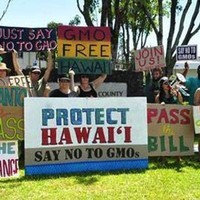
And communities in numerous states subject to preemption revealed the desire of localities to take action to protect their residents. In California, the cities of Irvine and Malibu passed organic focused pesticide reform ordinances. Following Minneapolis, MN’s organic focused resolution in 2015, its twin City of St. Paul, MN followed suit, echoing a request to the state to roll back state preemption policies that stop them from going further to restrict pesticides. As legal challenges in Hawaiian Counties and Montgomery County, MD show, the fight for local authority over toxic pesticide use continues.
As more schools and localities, like Villanova University, Antioch College, Macalester College, Milwaukie, OR, Howard County, MD and numerous Minnesota communities, continue to implement policy changes that protect pollinators from hazardous neonicotinoid insecticides, in 2016 we began to see states take part. In Maryland, the Pollinator Protection Act removes neonicotinoids from store shelves, and in Connecticut, An Act Concerning Pollinator Health passed unanimously through the legislature, enacting a range of common-sense protections for pollinators. As a result of coordinated advocacy efforts and over 15 local policies in Minnesota, Governor Dayton’s executive order made significant strides at addressing neonicotinoid use in agriculture.
Our work in Ogunquit and South Portland, Maine led to a teach-in at the Maine Organic Farming and Gardening Association (MOFGA) Country Fair in September to share with people across the state and northeast the experience of these communities and strategies for expanding the policy to other jurisdictions statewide. You can watch Part 1 of the session and Part 2 here. Nationwide, we continue to advance the pace of local policies and practices that embrace organic principles of land management.
In an effort to grow the pesticide reform movement, we launched the Map of U.S. Pesticide Reform Policies to show the widespread demand for pesticide restrictions and provide a tool, and accompanying blueprint, for advocates to use as they begin working in their community. We hope you’ll get in touch with us in the New Year to tell us about your efforts and how we can help bring them to fruition.
Bring on the goats
Goat grazing: is an effective tool for invasive and vegetation plant management and re-seeding; restores the land to life, heals the soil, and encourages ecosystem services to function; leads to plant resilience, which helps prevent future problems; and, increases soil organic matter, enhances soil health and moisture, decreases erosion, and supports desired plant species diversity with higher plant vigor. And, it’s a fire mitigation tool!
We brought a herd of 500 goats to conduct an intensive, managed goat grazing operation to manage invasive weeds on 300 acres of tribal lands of the Washoe Tribe of Nevada and California. We spoke before the Tribal Council about using goats for land management, healing the land, and stopping all herbicide use. This project reflects our deep commitment to show that the kind of change we advocate for as an organization is not only possible, but offers an approach that is more effective with long-term cost savings. That’s because we respect nature to reach a sustainable ecological balance. Our work shows how it is done and is a model for other land managers, Tribes, and communities across the nation. It can be used in urban areas, too!
Protecting organic integrity
We advance sustainable and organic practices with our food dollars. But, that requires that we hold the manufacturers and retailers accountable to the standards that are critical to protecting health and the environment. We published When Sustainable Is Less Than Organic, Is It Responsibly Grown?, which raises critical issues on alternative food labeling that undermines the organic label. Whole Foods Market‚Äôs Responsibly Grown rating system has been criticized as undermining the organic market by creating a set of standards based on criteria that do not utilize organic practices, values, and principles as its baseline. This allows products and commodities rated as ‚Äúresponsibly grown‚ÄĚ to utilize a range of toxic inputs, including synthetic pesticides and fertilizers that are not permitted under organic standards as codified in the Organic Foods Production Act (OFPA). If the scheme was adding elements that have not yet been embraced by organic certification ‚Äďsuch as farmworker protection, humane treatment and pasturing of animals, elevated restrictions of some controversial synthetic substances allowed in organic‚Äď then Responsibly Grown could have been envisioned as improving elements of sustainability within the organic framework. We continue to challenge the value of Integrated Pest Management (IPM) as a meaningful concept, given its lack of a definition and dependency on toxic chemicals that harm soil health. We sued General Mills for false and deceptive labeling on a product that carries the “natural” label, despite one of the major ingredients being treated with the herbicide glyphosate.
Making sure that organic complies with OFPA is a critical piece of what we as a network must focus on in the year ahead. To that end, we‚Äôve set up our webpage Keeping Organic Strong ‚Äďour way of engaging organic consumers and growers in ensuring the integrity of the certified organic label.
Bee Protective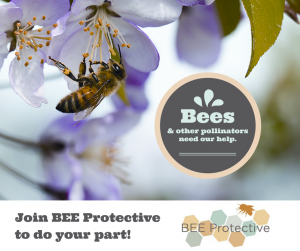
Pollinators continue to be an entry point for many people to engage in the larger issue of pesticide hazards and organic. Our challenge, through our pollinator campaign, called Bee Protective, is to keep the focus on neonicotinoids as symptomatic of a hazardous chemical-intensive food production and land management system and a failed regulatory system with inadequate protections. In this context, we seek to show that a chemical-by-chemical strategy does not move us off the pesticide treadmill, but on to the next family of chemicals with a new or continuing set of problems. We track the science on pesticides and pollinators and have one of the most thorough and up-to-date databases on the scientific literature, called What the Science Shows. We have developed a teaching curriculum on pollinators that we are providing to school systems and a pollinator starter kit. And, we launched a restaurant campaign to coincide with National Pollinator Week.
The National Forum- Mark your calendar
To help support local aCction, we’re holding our 35th national conference, Healthy Hives, Healthy Lives, Healthy Land: Ecological and Organic Strategies for Regeneration at the University of Minnesota, Minneapolis on April 28-29, 2017. Please join us. We maintain a uniquely informative video library of Forum speakers, including leading scientists, researchers, legislators, lawyers, farmers, and land managers. Check out the videos from the 2016 Forum, Cultivating Community and Environmental Health, at the University of Southern Maine in Portland, Maine.
Keeping regulatory deficiencies in the forefront
Our work to critique ongoing EPA regulatory decisions remains important as we seek to effect a shift to organic and ecological practices. Whether it is our comments on glyphosate or the systemic insecticide sulfoxafor, a neonicotinoid cousin, we point out the deficiencies with the agency’s analysis. This was the case with the use of the organophosphate Naled spraying for the threat of Zika virus transmission and EPA and Centers for Disease Control and Prevention (CDC) proclamations of the insecticide’s safety. We wrote to EPA to point out the deficiencies in its assessment of bystander exposure to Naled and put out a press release, EPA and CDC Mislead Local and State Officials and the Public on Safety of Mosquito Pesticides Used for Zika Virus. EPA wrote us back, acknowledging that it was seeking more information on the threat associated with Naled exposure through mosquito spray programs. With the large bee kill in South Carolina after a mosquito spraying, our piece, Mosquito Control and Pollinator Health: Protecting Pollinators in the Age of Zika and Other Emerging Mosquito Diseases, was timely.
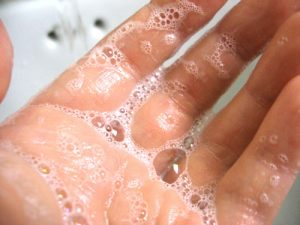
The Food and Drug Administration (FDA) announcement that it was phasing out triclosan and other antimicrobials from liquid soaps gave us an opportunity to declare a regulatory victory and at the same time point out the deficiencies in allowing continued use in toothpaste and non-cosmetic products, such as socks, underwear and other textiles, hair brushes, cutting boards, computer keyboards, toys and other plastics (regulated by EPA).  Since 2004, Beyond Pesticides has worked to bring public attention to the dangers surrounding the proliferate use of triclosan in consumer goods. A petition submitted to both FDA and EPA by Beyond Pesticides in 2010 calls for the ban on triclosan based on the unnecessary health and environmental risks involved with its use, given the availability of safer alternatives. With the growing public awareness and the evolving market shift away from triclosan, the time is now for a complete federal ban on this unnecessary chemical. We argue that FDA should expand its ban on triclosan in hand soaps to all over-the-counter products, including toothpaste. And, it is critically important that EPA now step up to do the same for all the consumer product uses that it regulates. Beyond Pesticides’ work, joined by others, resulted in many manufacturers voluntarily removing triclosan from its products. Because of our work, by the time that FDA stepped in, there was little opposition to regulatory action.
Genetic Engineered Ingredient Labeling
With the growth of genetically engineered (GE) crops, we have learned that farmers are using more pesticides on herbicide-tolerant plants and seeing more weed resistance, which is forcing the development of new more toxic pesticide formulations. Genetic drift contaminates organic and the public is kept in the dark about which food products on the grocery store shelves contain GE ingredients. Meanwhile, despite losses on the federal and state front to require labeling, with public pressure companies started to respond ‚Äďbut is it misleading? Starting with Campbell‚Äôs Soup Company, companies announced that they will label for genetically engineered ingredients and then supported mandatory labeling requirements, leading to the passage of the Biotechnology Food Labeling and Uniformity Act¬†(S.2621), which requires weak labeling, and preempts states from adopting different and stronger language, such as a warning. ¬†Expect to see language on the companies‚Äô website like, ‚ÄúThe overwhelming weight of scientific evidence indicates that GMOs are safe and that foods derived from crops using genetically modified seeds are not nutritionally different from other foods.‚ÄĚ Our goal is to make sure that GE ingredients and contamination does not invade organic production and products.
Breaking through Power
Our participation in the Ralph Nader event, Breaking through Power (held at Constitution Hall in Washington, DC in September), provided us with a forum to capture the importance of Beyond Pesticides’ mission and work in a 20-minute presentation. Introduced by Jim Hightower, we shared the history of the organization and its vision going forward. It is important to note that we were among the only, if not the only, organization of less than 20 organizations asked to speak that was not founded or supported at its founding by Mr. Nader, but certainly inspired by his advocacy in the public interest. In the years since Beyond Pesticides’ founding, Mr. Nader has spoken at Beyond Pesticides’ forums and supported our work.
Providing the tools for effective action
We maintain and enlarge Beyond Pesticides’ science and policy databases, which serve as an important counterweight to government agencies that ignore the independent peer-reviewed scientific literature. We have grown our Gateway on Pesticide Hazards and Safe Pest Management and Pesticide-Induced Diseases Database, which document the preponderance of science that justifies the policies and practices we advance. We conduct ongoing independent assessments of product ingredients and the supporting science to evaluate their impact on health and the environment. Together, this information supports, in real time, the need for elected officials to advance local policy in the face of federal standards that are not protective of health and the environment.
Happy Holidays and New Year
We will not accept a future with continued and rising toxic pesticide use that threatens our health and the sustainability of the planet. We will build on the successes of the past to meet the challenges of the future.
Thank you again for joining with us this year to sustain and grow these victories. We hope you’ll take some time this holiday season to celebrate these accomplishments, and come together with us next year, refreshed and ready for the serious challenges and new victories that lie ahead.
Best wishes for the Holiday Season and New Year!

Posted in Agriculture, Alternatives/Organics, Announcements, Antibacterial, Beneficials, Chemicals, Environmental Protection Agency (EPA), Increased Vulnerability to Diseases from Chemical Exposure, Label Claims, National Politics, Pesticide Regulation, Pollinators, Resistance, Take Action, Triclosan, Uncategorized by: Beyond Pesticides
No Comments
23
Dec
(Beyond Pesticides, December 23, 2016) The Environmental Agency (EPA) has finalized a proposal to ban 72 inert (or secret hazardous) ingredients from use in pesticide formulations following a long fight with environmentalists who, in 2006, asked that pesticide product labels disclose any of 371 inert ingredients that could be in products. While this finalization is a step in the right direction, ultimately the move is viewed by advocates as inadequate. The original petition, submitted by Northwest Coalition for Alternatives to Pesticides, along with Beyond Pesticides, Physicians for Social Responsibility, and nearly 20 other organizations, called on the agency to require disclosure of inerts. To put the announcement in perspective, EPA is acting on 72 inert ingredients that are no longer being used, such as turpentine oil, and nitrous oxide.
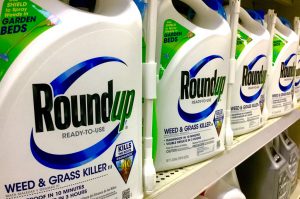
An inert ingredient is defined as any ingredient that is ‚Äúnot active,‚ÄĚ or specifically targeted to kill a pest. According to a 2000 report produced by the New York State Attorney General, The Secret Ingredients in Pesticides: Reducing the Risk, 72 percent of pesticide products available to consumers contain over 95 percent inert ingredients and fewer than 10 percent of pesticide products list any inert ingredients on their labels. The report also found that more than 200 chemicals used as inert ingredients are hazardous pollutants in federal environmental statutes governing air and water quality, and, from a 1995 list of inert ingredients, 394 chemicals were listed as active ingredients in other pesticide products. For example, naphthalene is an inert ingredient in some products and listed as an active ingredient in others.
Some inert ingredients are even more toxic than the active ingredients. One of the most hazardous ingredients in the commonly used herbicide Roundup, POEA, is a surfactant that is classified as an inert and therefore not listed on the label. Researchers have found that POEA can kill human cells, particularly embryonic, placental and umbilical cord cells.
Despite these uncertainties and potential hazards, pesticide manufacturers are only required to list the active ingredients in a pesticide under the Federal Insecticide, Fungicide and Rodenticide Act (FIFRA). This leaves consumers and applicators unaware of the possible toxicity present in a vast majority of the pesticide formulations they are using unless the EPA Administrator determines that the chemical poses a public health threat.
Background
In September 2009, EPA first responded to two petitions, one led by the Northwest Centers for Alternatives to Pesticides in 2006 (mentioned above), and a second by 15 State Attorneys General that identified over 350 inert pesticide ingredients as hazardous. The petitioners asked EPA to require these inert ingredients be identified on the labels of products that include them in their formulations.
Then, on December 23, 2009, EPA took another promising step forward with an Advanced Notice of Proposed Rulemaking (ANPR), announcing its intention to seek public input on developing an inert ingredient disclosure rule. Putting forth two proposals, one to require listing all ingredients already identified as hazardous, and the other to require the listing of all ingredients on product labels. EPA then took no further action. As a result, some of the original petitioners filed an ‚Äúundue delay‚ÄĚ complaint against EPA in March 2014 for failing to complete rulemaking that would require pesticide manufacturers to disclose the inert ingredients on their pesticide product labels.
In response to that lawsuit, EPA retracted its previous ANPR and intention to move forward with rulemaking. Instead, EPA issued a letter to the original 2006 petitioners describing its intentions to seek non-rulemaking regulatory programs and voluntary disclosure standards, stating, ‚ÄúIn sum, [EPA] believe[s] we have identified a more effective and timely way to achieve our common objective; but, because this approach would no longer pursue the rulemaking the EPA initiated via the [ANPR] seeking to mandate the disclosure of potentially hazardous inert ingredients on pesticide labels, as requested in the 2006 petitions, this amended response constitutes a denial of the petitions.‚ÄĚ
EPA then used its change of position on issuing rulemaking and denial of the 2006 petition as a basis to have the undue delay lawsuit thrown out. This decision was challenged by environmental groups, but a federal judge in California handed down a decision in June 2016 agreeing with the EPA that it has no responsibility under federal pesticide law to complete rulemaking on the disclosure of hazardous ingredients in pesticide products.
Beyond Pesticides has long advocated a regulatory approach ¬†that prohibits hazardous chemical use and requires alternative assessments to identify less toxic practices and products under the unreasonable adverse effects clause of FIFRA. ¬†Beyond Pesticides was a co-plaintiff in the successful lawsuit Northwest Coalition for Alternatives to Pesticides et al. v. EPA (Civil Action No. 94-1100, 1996), in which the court ruled that ‚Äúinert‚ÄĚ ingredients should not be given blanket trade secret protection by EPA under the Freedom of Information Act (FOIA). In that case, the plaintiffs successfully argued that EPA must disclose inert ingredients since their secrecy from public disclosure served no proprietary interest for the chemical manufacturer. This same argument holds with respect to the product label.
The failure of EPA to require the disclosure of inert ingredients poses many problems for those trying to protect human health. Failure to disclose the ingredients not only prevents consumers and decision makers from making informed decisions and comparing hazards. Local and state governments also run into roadblocks in their efforts to protect citizens, as they cannot readily evaluate what is in the pesticides products (formulations) that they are spraying in their communities to make independent judgments on safety, putting their citizens at risk. Under the prevailing laws, it is EPA’s duty to assess these risks and disclose the necessary information, through pesticide labels, as to what harmful ingredients pesticides contain.
Environmental groups, including Beyond Pesticides, have consistently urged EPA to follow in the steps of countries like Canada and the European Union by following the precautionary principle, which generally approves products after they have been assessed for harm, not before. Beyond Pesticides suggests an approach that rejects uses and exposures deemed acceptable under risk assessment calculations, and instead focuses on safer alternatives that are proven effective, such as organic agriculture, which prohibits the use of toxic chemicals.
Source: EPA
All unattributed positions and opinions in this piece are those of Beyond Pesticides.
Posted in Agriculture, Alternatives/Organics, Announcements, Beneficials, Birth defects, Cancer, Chemicals, contamination, Corporations, Disease/Health Effects, Endocrine Disruption, Environmental Protection Agency (EPA), Monsanto, Pesticide Regulation, Pesticide Residues by: Beyond Pesticides
No Comments
22
Dec
(Beyond Pesticides, December 22, 2016) Legislation passed Monday in the District of Columbia stops the use of toxic pesticides near schools, child-occupied facilities, waterbody-contingent property, and public property. The Pesticide Education and Control Amendment Act (PECCA) of 2016 (Bill B21-0580), passed unanimously by the District Council, strengthens previous law to protect children and residents living in Washington DC from unnecessary pesticide exposure. The law places the District at the forefront with other communities around the country that are phasing out the use of toxic pesticides in building and land management.
The legislation, sponsored by Councilmember Mary Cheh, clarifies certain provisions of the original PECCA passed in 2012, which had not been implemented by the Department of Energy and Environment (DOEE) in accordance with the original spirit and intent of the law. The new law clarifies the department responsibility to prohibit all pesticide use near schools and waterbody-contingent properties, except a defined list of material allowed in organic land management. The law is intended to effect a transition to sustainable and cost-effective insect and weed management practices in the District.
Jay Feldman, Executive Director of Beyond Pesticides, said: ‚ÄúThis law protects vulnerable populations, like children, from the dangers of unnecessary toxic pesticide use near schools and daycare centers, and prevents contamination of the environment and waterways on public and private land. We are pleased with the District‚Äôs decision to only permit products allowed for use in organic land management in these areas.‚ÄĚ
Alan Cohen, President of BioLogical Pest Management Inc. said of the Council‚Äôs vote, ‚ÄúThis is a huge step in the right direction for the District of Columbia. This law will help shift the industry in a way that still meets solves pest problems for consumers, but is far safer for humans, pets and the environment.”
Since the original law was adopted by the District in 2012, surrounding jurisdictions, including Takoma Park and Montgomery County, Maryland have banned toxic cosmetic pesticide use on public and private land within their jurisdictions. Pesticides move off the target site through drift and runoff, exposing non-target sites and people. Beyond Pesticides has mapped 115 communities in 21 U.S. states that have taken local action to protect their communities from the adverse effects of pesticides in the face of daily toxic chemical use ‚Äďwith a range tactics, from eliminating highly toxic chemicals to the adoption of organic practices. See more information on Map of U.S. Pesticide Reform Policies.
For information on organic land management, see Beyond Pesticides’ Lawns and Landscapes page and see Beyond Pesticides website for up-to-day information on pesticide hazards and alternatives.
See a copy of our press release here.
Contacts:
Beyond Pesticides, Jay Feldman, [email protected], 202-543-5450,
Annie D’Amato, [email protected], 202-543-5450.
All unattributed positions and opinions in this piece are those of Beyond Pesticides.
Posted in Alternatives/Organics, Announcements, Children/Schools, contamination, Environmental Protection Agency (EPA), Lawns/Landscapes, National Politics, Pesticide Drift, Pesticide Regulation, Pesticide Residues, State/Local, Washington D.C. by: Beyond Pesticides
No Comments
21
Dec
(Beyond Pesticides,¬†December 21, 2016) A California Department of Pesticide Regulation (DPR)¬†report¬†of all pesticide related illnesses in the state in 2014 identifies¬†1,685 cases ‚Äúpotentially involving health effects from pesticide exposure,‚ÄĚ combining exposures from agricultural and¬†non-agricultural use. Of the 798 cases associated with non-agricultural use, 18% of them (146 cases) involved exposure in children under 18 years old. The exposure rates are alarming, and only strengthen efforts by local activists in counties like Tulare to protect children from pesticide exposure. According to the report, Tulare County has the highest number of reported illnesses related to pesticide exposure at 78, followed by Santa Cruz County with 67.
The report, Summary of Results from the California Pesticide Illness Surveillance Program 2014, provides a summary of illnesses identified by the Pesticide Illness Surveillance Program (PISP), a program under DPR. Of the 1,685 cases potentially involving health effects from pesticide exposure reported, DPR epidemiologists determined that 1,073 of those cases were ‚Äúat least possibly associated‚ÄĚ with pesticide exposure, representing a 5% decrease from 2013. However, even though the number of associated cases decreased in 2014, PISP did see a 14% rise in the number of associated episodes, defined as ‚Äúan event in which a single source possibly, probably, or defin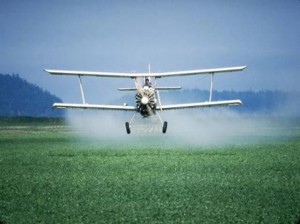 itely exposed one or more people (cases) to pesticides.‚ÄĚ The number of cases associated with non-agricultural pesticide use also increased, up 16% from 2013 for a total of 798 cases. Of those 798 cases, 34% of them were defined as occupational, meaning that they occurred while the affected people were at work. PISP also looked in injuries to agricultural field workers, finding that 148 workers were affected by pesticide exposure in 25 different episodes, with 40 being the largest number of workers injured at one time.
itely exposed one or more people (cases) to pesticides.‚ÄĚ The number of cases associated with non-agricultural pesticide use also increased, up 16% from 2013 for a total of 798 cases. Of those 798 cases, 34% of them were defined as occupational, meaning that they occurred while the affected people were at work. PISP also looked in injuries to agricultural field workers, finding that 148 workers were affected by pesticide exposure in 25 different episodes, with 40 being the largest number of workers injured at one time.
These increases are indicative of a need for increased protections from pesticide exposure for the people of California. Since this fall, public health advocates have been at odds with the state over a proposed rule intended to protect children by establishing buffer zones around schools. The proposed rule, Pesticide Use Near Schoolsites, proposes only limited restrictions for certain agricultural pesticide applications near schools and child day care facilities. It would require farmers to notify public schools and child day care facilities when ‚Äúcertain pesticide applications made for the production of an agricultural commodity near a school site are planned in the coming year and also a few days prior to the applications.‚ÄĚ For pesticides applied via aircraft, airblast sprayer, sprinkler chemigation, and fumigation, there must be a minimum ¬ľ mile buffer around the school or child day care facility. Advocates say that while the move by CDPR is a step in the right direction, it is not rigorous enough, buffer zones are well below the¬†one mile distance necessary, and does not adequately protect the most vulnerable populations from pesticide exposure. The rule does not include private K-12 schools or family day care homes, a move that according to¬†CDPR documents¬†is due to the potential for increased costs to businesses and regulated entities. Additionally, the rule only applies to pesticide application activities Monday through Friday, during the hours of 6am to 6pm. Advocates say that these are unacceptable holes in this proposed rule and must be addressed before the final rule is published.
In Tulare County, the place with the highest number of reported pesticide related illnesses in 2014, more than 75 parents, teachers and advocates for social and environmental justice marched this fall to protest DPR’s draft rules for pesticides use near schools. Led by members of the Tulare County Coalition Advocating for Pesticide Safety (TCCAPS), the protesters say that the regulations fall short in protecting school children and staff from pesticides that drift from nearby agricultural spraying.  Parents and teachers want to extend the buffer zone to one mile, as it has been studied that pesticide drift can travel even greater than a mile away from its original application site. In fact, pesticide particles can attach themselves to air masses and be deposited across the globe. Agricultural pesticide exposure is linked to serious childhood health concerns, including asthma, autism, cancer and developmental and neurological damages.
In 2014, the California Department of Health released a report, Agricultural Pesticide Use Near Public Schools,¬†that for the first time documented the use of the most hazardous agricultural pesticides near public schools in 15 of California‚Äôs agricultural counties. The report shed light on the use of more than a half a million pounds of 144 different chemicals that could be a cause for health concerns used within ¬ľ¬†mile of public schools. Tulare County had the highest percentage of schools with pesticides of public health concern applied within ¬ľ mile ‚ÄĒ63%, or 123 of Tulare County‚Äôs 194 public schools. Racial disparities were also identified. According to the report, ‚ÄúIn the 15 counties assessed, Hispanic children were 46% more likely than White children to attend schools with any use of pesticides within ¬ľ mile, compared to children attending schools with no pesticide use within ¬ľ mile.‚ÄĚ Even more striking, the report finds that, ‚ÄúThis difference was more pronounced with increased pesticide use, as Hispanic children were 91% more likely than White children to attend a school in the top quartile of pesticide usage, when compared to children attending schools with no pesticide use nearby.‚ÄĚ
In Santa Cruz County, activists are also concerned about the study findings, which placed them second in the state for most pesticide related illnesses right behind Tulare. Lucia Calderon, organizer of the statewide coalition Safe Ag Safe Schools, speaking about Santa Cruz County, said ‚Äúit is concerning to us that a relatively small county has such a large proportion of illnesses related to agricultural pesticides, especially in a place where treated fields are so close to schools and neighborhoods, it is crucial that the DPR takes action to truly reduce the incidence of pesticide drift and subsequent poisonings.‚ÄĚ Ms. Calderon also advocates for one-mile buffer zones around schools, largely due to a report published in 2011 that found 82 percent of pesticide exposure occurs more than a quarter-mile away from the application site. ‚ÄúA ¬ľ¬†is not enough to protect from pesticide drift and illness,‚ÄĚ she said Tuesday, ‚Äúto protect public health and make sure agricultural pesticide illness is truly reduced, Santa Cruz County and the entire state need full-time, full-mile buffer zones around schools.‚ÄĚ
Beyond Pesticides does not believe that the ¬ľ mile buffer zone is rigorous enough to protect public health from pesticide drift. Other deficiencies¬†in the proposed¬†regulation include the rule‚Äôs limited scope in only addressing public schools, leaving out private K-12 schools and private day care facilities. The time to submit comments on this issue has passed, as of December 9, 2016, but there are still ways you can get involved. Learn more about the dangers of pesticide drift by looking at our fact sheet on pesticide drift. Also, as a food consumer, the best way to protect farmworkers, their children, and rural communities from pesticide use and exposure is to buy organic food in the grocery store. Beyond Pesticides‚Äô¬†Eating with a Conscience¬†¬†identifies the range of pesticides used in chemical-intensive food production that is eliminated from use in organic production. To learn more about the campaign for social justice food labeling and the Agricultural Justice Project (AJP), see¬†Social Justice Food Labeling: From food to table. For more information, see Beyond Pesticides‚Äô¬†Agricultural Justice webpage.
Source: Register Pajaronian, CDPR
All unattributed positions are that of Beyond Pesticides.
Posted in Agriculture, Alternatives/Organics, California, Chemicals, contamination, Disease/Health Effects, Endocrine Disruption, Environmental Justice, Farmworkers, Learning Disabilities, National Organic Standards Board/National Organic Program, Nervous System Effects, Pesticide Drift, Pesticide Regulation, Respiratory Problems, State/Local, Take Action by: Beyond Pesticides
No Comments
20
Dec
(Beyond Pesticides, December 20, 2016) A long-awaited and contentious scientific meeting convened by the U.S. Environmental Protection Agency (EPA) on the carcinogenic properties of glyphosate wrapped up its review last week, with the 15-member scientific advisory panel split on their determination,¬† and some considering a ‚Äúsuggestive evidence‚ÄĚ classification. The panel‚Äôs charge was to evaluate EPA‚Äôs recent proposal that the widely used herbicide should be considered ‚Äúnot likely to be carcinogenic to humans,‚ÄĚ despite a 2015 determination from the International Agency for Research on Cancer than glyphosate is ‚Äúprobably carcinogenic‚ÄĚ with ‚Äúsufficient evidence of carcinogenicity‚ÄĚ based on laboratory studies. ¬†The panel now has roughly three months to provide a final¬†recommendation to the agency, which is likely to influence EPA‚Äôs final classification of the herbicide.
The meeting was split into four days, with one and a half days committed to the panel receiving public comment s. As veteran reporter Cary Gillam notes in The Huffington Post, representatives from Monsanto were allotted over three hours to provide evidence against a cancer determination, while public health advocates including Beyond Pesticides and allies were only allotted between 5-15 minutes to make their case. [Read Beyond Pesticides‚Äô comments to the Glyphosate Review Panel here.] Monsanto, for its part, spent much of its allotted time trying to discredit Kenneth Portier, PhD, who they did not want on the panel, and accused of having a conflict of interest partly because his brother is, according to industry trade group Croplife America, ‚Äúa noted and vehement anti-glyphosate activist.‚ÄĚ ¬†Prior to the meeting, Croplife worked behind the scenes to remove another panel member, Peter Infante, Dr.PH, for what it claimed was his bias against the chemical industry, and the likelihood he would give more weight to independent, rather than industry-funded science. Despite his removal and industry allegations, Dr. Infante gave a public comment to the panel, providing substantial evidence on glyphosate‚Äôs carcinogenic properties, and suggestions on ensuring more robust epidemiological data.
s. As veteran reporter Cary Gillam notes in The Huffington Post, representatives from Monsanto were allotted over three hours to provide evidence against a cancer determination, while public health advocates including Beyond Pesticides and allies were only allotted between 5-15 minutes to make their case. [Read Beyond Pesticides‚Äô comments to the Glyphosate Review Panel here.] Monsanto, for its part, spent much of its allotted time trying to discredit Kenneth Portier, PhD, who they did not want on the panel, and accused of having a conflict of interest partly because his brother is, according to industry trade group Croplife America, ‚Äúa noted and vehement anti-glyphosate activist.‚ÄĚ ¬†Prior to the meeting, Croplife worked behind the scenes to remove another panel member, Peter Infante, Dr.PH, for what it claimed was his bias against the chemical industry, and the likelihood he would give more weight to independent, rather than industry-funded science. Despite his removal and industry allegations, Dr. Infante gave a public comment to the panel, providing substantial evidence on glyphosate‚Äôs carcinogenic properties, and suggestions on ensuring more robust epidemiological data.
The panel leveled a number of criticisms for how EPA conducted its cancer review. Some recommended that the agency consider other forms of glyphosate beyond the pure acid isopropylamine salt form. According to Bloomberg BNA, Eric Johnson, PhD, asked the agency for data comparing cancer rates between farmers who spray glyphosate and factory workers who produce it. This comparison would help the panel determine whether it was pure glyphosate that was cancer-causing or the mixture of glyphosate with other inert ingredients. However, EPA indicated that it did not have jurisdiction to gather that data, and alarmingly, industry representatives also refused to supply it. ‚ÄúWe‚Äôre asking EPA to be transparent, but we‚Äôre not seeing that from industry,‚ÄĚ Dr. Johnson said to Bloomberg BNA. ‚ÄúThese are the types of things that make people suspicious of industry.‚ÄĚ
The scientific panel also critiqued EPA‚Äôs search criteria for sourcing studies to be included in the review. There were disagreements with EPA‚Äôs decision to discount certain studies based on ‚Äúlow quality/value/study power‚ÄĚ rankings by the agency, as well as the exclusion of certain terms, for example the term water was excluded when searching for studies because the agency didn‚Äôt want ecological aquatic data, but this in turn meant that any potential drinking water studies were also excluded. As a result, EPA‚Äôs weight of evidence approach was skewed towards industry data.
While the panel’s review will make a significant impact on EPA’s classification for glyphosate, even if the chemical were determined to be likely carcinogenic by the agency, it is unlikely that it would precipitate its cancellation. That is because, more often than not, when a pesticide shows adverse effects EPA will simply require label changes or limited restrictions that change, but does not eliminate the risk associated with a chemical. Health Canada’s recent reevaluation and proposal for glyphosate provides an analogous regulatory example.
To hasten glyphosate’s elimination from our environment, there are a range of actions that concerned people can take today. Start by buying organic, as this will support an agricultural system that is not reliant on, and in fact never permits the use of glyphosate or any other toxic synthetic pesticides. You can also urge your local grocery store and garden center to stop selling glyphosate, or any product that has ever been sprayed with the chemical. Possibly the most effective move you can make is to get active in your local community. Beyond Pesticides has resources, including a newly released Map of U.S. Pesticide Reform, to help folks concerned about glyphosate take action to reduce and eliminate its use.
For more information about glyphosate, its cancer determination, and what you can do see Beyond Pesticides’ fact sheet on glyphosate, comments to EPA review panel, and the Pesticides and You article, Glyphosate Causes Cancer: Is Monsanto Ready for the Consumer Response?
Source: Huffington Post, Bloomberg BNA, Agri-Pulse
All unattributed positions and opinions in this piece are those of Beyond Pesticides.
Posted in Agriculture, Alternatives/Organics, Announcements, Cancer, Chemicals, contamination, Corporations, Disease/Health Effects, Endocrine Disruption, Environmental Justice, Environmental Protection Agency (EPA), Glyphosate, Monsanto, Pesticide Regulation, Pollinators, State/Local, Uncategorized by: Beyond Pesticides
1 Comment
19
Dec
(Beyond Pesticides, December 19, 2016) The U.S. Environmental Protection Agency (EPA) last week filed a complaint against a Syngenta research farm in Kauai, Hawaii for exposing a dozen agricultural workers to an unregistered insecticide on the farm in early 2016. Syngenta Seeds, LLC is facing over $4.8 million in fines from EPA for allegedly violating multiple federal pesticide regulations meant to protect agricultural workers. At the time of the incident, 19 agricultural workers went to work on fields freshly sprayed with the insecticide chlorpyrifos, an organophosphate insecticide. The incident with this highly neurotoxic chemical sent 10 workers to the hospital for medical treatment.
EPA‚Äôs complaint states that Syngenta Hawaii LLC misused the pesticide ‚ÄúLorsban Advanced‚ÄĚ and that violated EPA’s¬†worker protection standard.¬†Due to its neurotoxicity, EPA banned chlorpyrifos for residential uses in 2000, but retained most¬†agricultural use.¬†EPA maintains that Syngenta failed to provide a waiting period for the workers to re-enter the fields. Additionally, Syngenta did not provide workers with personal protective equipment, as well as proper decontamination supplies once the exposure had occurred.
At the time of the incident, an inspector from the Hawaii Department of Agriculture (HDOA) was present on the Syngenta farm, which triggered an immediate investigation from the state.¬†In March, HDOA notified EPA of the matter, which led to a follow-up investigation from the agency later in April that resulted in¬†the civil fines. Residents living on the Hawaiian Islands are subject to¬†ongoing pesticide exposure from experimental farms because of the state‚Äôs pristine growing conditions that make¬†it a prime area for agrichemical companies to test new, experimental chemicals and crops, including¬†new genetically engineered (GE) crops. Data released last year reveals that¬†high levels of restricted use pesticides, in some cases almost double the pounds per acre average of other states, are being used in Kauai County. According to the Center for Food Safety, in¬†2014 alone¬†there were 1,381 field test sites in Hawaii, compared to only 178 sites in California ‚Äďa large agricultural state. Most of these crops are engineered to tolerate applications of herbicides and other pesticides. Testing these crops means repeated spraying of hazardous chemicals near neighborhoods, schools, and waterways. Residents of the Hawaiian Islands that live, work, or go to school near these fields are¬†subject to incessant¬†pesticide¬†spraying, as the climate provides a year-round growing season for GE crops.¬†A May 2014 report¬†found 25 herbicides, 11 insecticides, and 6 fungicides in Hawaii‚Äôs waterways, underscoring resident concerns for both the land and human health.
Worrisome pesticide poisoning incidents are common in Hawaii. In August 2016, Earthjustice sent EPA a letter to EPA requesting that the agency notify HDOA of its chronic failure to carry out its regulatory and enforcement responsibility under federal law, the Federal Insecticide, Fungicide and Rodenticide Act (FIFRA). Earthjustice urged EPA to rescind HDOA’s primary enforcement authority (the authority delegated to the state under FIFRA) unless corrective action was taken. Problems identified by Earthjustice include a failure to enforce pesticide use violations and a large backlog of pesticide complaints and investigations dating back to as early as 2008. Had the HDOA inspector not been onsite at the time of the exposure, this incident could have been another incident left to be determined and added to the backlogged incident reports.
EPA has been warning HDOA repeatedly since 2012 that it has failed to adequately enforce pesticide laws and has allowed an unacceptable backlog of inspection files to grow. Instead of increasing its staff, HDOA’s enforcement staff has been steadily shrinking, and the number of inspections and enforcements have been decreasing every year. EPA’s most recent annual review of HDOA’s performance noted there were approximately 700 inspection files in need of review, some dating back to 2008. As a result, there have not only been enforcement delays, but some cases can no longer be acted on because the statute of limitations expired while files sat on HDOA’s desk.
Beyond Pesticides continues to be an ardent supporter of common sense protections from pesticides and their associated use in agriculture and on GE crops. If you too support these issues, please visit our website, give us a call at 202-543-5450, or email us at [email protected] to learn more about the issues and find ways to get involved in your local community.
Source: KHON2
All unattributed positions and opinions in this piece are those of Beyond Pesticides.
Posted in Agriculture, Alternatives/Organics, Announcements, Chemicals, Children/Schools, Chlorpyrifos, contamination, Corporations, Disease/Health Effects, Environmental Justice, Environmental Protection Agency (EPA), Farmworkers, Hawaii, Pesticide Regulation, Pesticide Residues, State/Local, Syngenta by: Beyond Pesticides
No Comments
16
Dec
(Beyond Pesticides, December 16, 2016) A new meta-analysis has challenged the belief that neonicotinoid (neonic) insecticide seed coatings have little to no effect on the health of beneficial predatory insect populations ‚ÄĒon the contrary, researchers have found that the seed coatings impact predatory insects as much as broadcast applications of other insecticides. The study, authored by Margaret Douglas, PhD and John Tooker, PhD, of Penn State University, solidifies previous work that shows beneficial predators are affected through secondary poisoning as a result of neonicotinoid seed coatings.
For their meta-analysis, the researchers combined the results of approximately 1,000 observations for field studies across North America and Europe that had looked at the effect of neonicotinoid seed coatings on predatory insects. The researchers compiled datasets that compare predatory insect abundance in plots that are planted with coated seeds to control plots, which are either managed without insecticides, or managed with pyrethroid insecticides. As predicted, the population of predatory insects are reduced in the plots where coated seeds are planted, compared to the plots that are untreated by insecticides. Additionally, the meta-analysis finds that coated seeds affected predatory insect populations similarly to soil and broadcast applications of pyrethroids.
Generally, these findings indicate that the use of neonicotinoid seed treatments, which are intended to decrease the use of pesticides, can actually increase the necessity of these toxic chemicals by killing off natural, beneficial insect predators. Thus, these seed treatments are ineffective and cause more harm than good. It would better serve farmers and the environment to actively encourage natural predation, rather than rely on toxic chemicals that only perpetuate the dangerous cycle of escalating pesticide use.
In 2015, another study authored by Dr. Douglas demonstrates that natural enemy insects could be affected by neonic-coated seeds, through a previously unexplored pathway. Dr. Douglas found that seed treatments using the neonicotinoid thiamethoxam, a toxic insecticide that is supposed to affect pest slugs, instead bioaccumulated and then transferred through the slugs into their insect predators, impairing or killing >60%. This resulted in a loss of crop due to a decline in beneficial insect predators and an increase in pest slug population.
This meta-analysis adds merit to the body of research regarding neonicotinoids and their impacts on pollinators and other non-target beneficial species. Neonicotinoids are a relatively new class of insecticides that share a common mode of action that affects the central nervous system of insects, resulting in paralysis and death. While the issue of pollinator declines is diverse and complex, with many factors potentially contributing to the cause, pesticides have consistently been implicated as a key factor, not only through immediate bee deaths, but also through sublethal exposure causing changes in bee reproduction, navigation and foraging. Further research has demonstrated that neonicotinoids create increased vulnerability to diseases through exposure, impact a wide range of habitats, and have persistent, long term implications.
Neonicotinoids are undoubtedly highly toxic to honey bees, and EPA acknowledges this fact. However, little is being done at the federal level to protect bees and other pollinators from these pesticides. With unlimited resources behind them, the chemical industry ‚ÄĒthe pesticide manufacturers, landscaping, horticultural and agricultural trade groups‚ÄĒ have all come out to deflect attention away from pesticides as a major culprit in pollinator decline. To learn more about how industry agents try to manipulate the message to say that neonics are not the main cause, see Beyond Pesticides’ report addressing industry myths on pollinator decline.
In light of the shortcomings of federal action  to protect these beneficial creatures, it is left up to us to ensure that we provide safe havens for pollinators by creating pesticide-free habitat and educating others to do the same. Beyond Pesticides has created a small pesticide-free garden at our offices in DC to provide habitat and forage for our local pollinators, including a beehive on site. You too can pledge your green space as pesticide-free and pollinator-friendly. It does not matter how large or small your pledge is, as long as you contribute to the creation of safe pollinator habitat. Sign the pledge today. Need ideas on creating the perfect pollinator habitat? The  Bee Protective Habitat Guide  can tell you which native plants are right for your region.
Source: Science Direct, PeerJ
All unattributed positions and opinions in this piece are those of Beyond Pesticides.  
Posted in Uncategorized by: Beyond Pesticides
No Comments
15
Dec
(Beyond Pesticides, December 15, 2016) On Monday, the U.S. Environmental Protection Agency (EPA) released the Certification of Pesticide Applicators final rule on restricted use pesticides (RUP) for publication in the Federal Register. According to EPA, the rule creates a national minimum age requirement of 18 for certified applicators, requires all applicators to renew their certifications every five years, and establishes ‚Äúfirst time annual safety training for persons working under the direct supervision of a certified applicator.‚ÄĚ States have up to three years to create their programs to implement the new rules for RUPs, and can build upon existing programs if they are equivalent or exceed the updated standards. While EPA’s rule represents a tightening of the restricted use provision, critics have long maintained that all persons handling restricted use pesticides ‚ÄĒincluding those who work for companies that work in and around ¬†homes and communities‚ÄĒ should be certified because the supervision requirement does not ensure adequate oversight and protection. Those supervising non-certified applicators are not required to be on site, but, can be in telephone contact.
Restricted use pesticides are not available for purchase by the general public, and may only be applied by a certified pesticide applicator or a non-certified individual working under their direct supervision. To highlight the danger associated with the use of these chemicals, EPA estimates that these changes in oversight will save between $13.2 and 24.3 million per year, directly attributable to fewer acute pesticide incidents to people. However, in its cost-benefit analysis, EPA failed to quantify the willingness to pay to avoid possible symptoms of pesticide exposure, and only estimated the avoided medical costs and lost wages.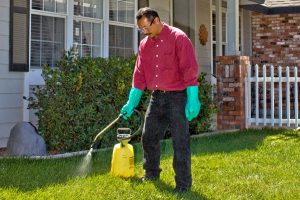
The EPA rule will cover all individuals that apply restricted use pesticides, including private applicators (individuals certified to use pesticides in agricultural settings), commercial applicators (individuals certified to use pesticides in non-agricultural settings), and those under the direct supervision of certified applicators. It is important to note that many states have already implemented a number of EPA’s standards. States have primary enforcement authority under the Federal Insecticide, Fungicide and Rodenticide Act (FIFRA) by agreement with EPA. However, these rules provide a new floor from which states can craft further measures to protect public and environmental health from highly toxic chemicals.
EPA’s rule establishes certification categories for private and commercial applicators covering higher risk application methods, including soil fumigation, aerial pest control, seed treatment, and forest pest control. At present, federal rules for private applicators have no specialized categories of certification, and commercial applicators require no additional certification to use specific application methods. Moreover, all certified applicators would be required to re-certify after a five-year period. Under current federal rules, certified applicators are only required to take a certification test once in their lifetime.
Many businesses and farm groups believe the new standards are too burdensome on pesticide applicators, citing increased time to meet training requirements and increased costs. However, with recent tragic pesticide poisonings, where preliminary evidence has been clear that pesticide applicators made gross errors in judgement and were possibly negligent, it is more important than ever for applicators to raise their standards of competency in making applications of hazardous pesticides.
Beyond Pesticides submitted comments to EPA last December when the rule revision was open for public comment. It is unfortunate that the standards were weakened from the originally proposed recertification every three years to every five years. The three-year recertification requirement would have harmonized the disparate recertification requirements across states. It is critical that states, which are charged with oversight for pesticide compliance and enforcement, are provided with the necessary resources to ensure pesticide applicators and applications are compliant with the new rules, and can conduct thorough investigations of reported incidents.
A current list of pesticides classified by EPA as restricted use is ¬†available on the agency‚Äôs website. While strengthening requirements regarding the use of these chemicals has been viewed as a necessary update, public health and environmental advocates have called for an overall shift away from toxic pesticide use, given the availability of safer alternative practices and products. The advocates have urged EPA to utilize its FIFRA authority to protect against “unreasonable adverse effects” by withdrawing registrations of pesticides for which there are less toxic alternatives. In fact, the agency acknowledges the qualitative benefits ¬†of the new rule to include reduced chronic effects, such as Non-Hodgkins lymphoma, prostate cancer, Parkinson‚Äôs disease, lung cancer, chronic bronchitis, and asthma to workers, handlers, and farmworker families. See Beyond Pesticides‚Äô ¬†Pesticide Induced Diseases Database for more information on the relationship between public health effects and pesticides.
While any strengthening of applicator standards is commendable, they do not solve the complex pesticide problems associated with pesticide mixtures and emerging science that threaten the functioning of organisms and ecosystems. ¬†EPA’s rule represents an incremental step forward. It is necessary to simultaneously reduce the overall approval, sale and use of pesticides that are proven to be hazardous to human and environmental health and for which there are safer alternatives. Through experience, Beyond Pesticides has found that nearly every pest problem can be adequately addressed through close adherence to cultural, mechanical, structural practices. Within an organic systems approach that seeks to avoid pesticide use, ecologically compatible biological products and least-toxic pesticides can be employed to address remaining issues. Organic methods of growing food and controlling pests are now tried and true, and present a stark contrast to the conventional, chemical-intensive pest control industry. Rarely, if ever, should such highly toxic chemicals that may result in life-altering health effects be employed by any individual. To learn more about the benefits of supporting organic, see Beyond Pesticides ¬†program page. For information on how to deal with pest problems through least toxic means, see ¬†ManageSafe database.
Sources: EPA, Farm Futures
All unattributed positions and opinions in this piece are those of Beyond Pesticides.
Posted in Environmental Justice, Environmental Protection Agency (EPA), Increased Vulnerability to Diseases from Chemical Exposure, Integrated and Organic Pest Management, National Politics, Pesticide Regulation, Rodenticide, State/Local, Washington D.C. by: Beyond Pesticides
No Comments
14
Dec
(Beyond Pestimcides,  December 14, 2016) Preliminary research presented this week at the British Ecological Society’s annual meeting identifies yet another troublesome connection between the use of neonicotinoid pesticides and the health of bees, a critical pollinator species. The research links neonicotinoid use with an impaired ability of bees to learn to vibrate flowers and shake out the pollen, which is necessary for fertilization in crops like tomatoes and potatoes. This research is consistent with other studies that link neonicotinoid use to reduced learning in bees, as well as other impacts such as those on their colony size and  reproduction, as well as contributions to overall declines.
Neonicotinoids (neonics) pesticides are a relatively new class of chemicals that affect plants in a systemic way, moving through the plants vacular system and expressed through pollen, nectar, and guttation droplets.  These pesticides,
:which include  imidacloprid, thiamethoxam and clothianidin, have been found by  a growing body of scientific literature  to be linked to Colony Collapse Disorder, a phenomenon where bees experience rapid declines from hive abandonment and bee die-off,  and  pollinator decline in general.  Neonics are associated with  decreased foraging  and navigational ability, as well as increased vulnerability to pathogens and parasites as a result of suppressed bee immune systems. In addition to toxicity to bees, pesticides like neonicotinoids have been shown to also adversely affect  birds,  aquatic organisms and contaminate soil  and  waterways, and  overall biodiversity.
For this study, researchers used two separate bumblebee colonies and split each colony into three different groups. Two of the groups were then exposed to the neonicotinoid thiamethoxam by being fed a solution, while the third group of each colony served as the control and was not exposed to the pesticide. The solution contained thiamethoxam at a rate of two parts per billion, or 10ppb of the pesticide, a concentration the researchers say mimics the exposure bees would find in crop fields. According to the report, ‚ÄúAfter each visit to the buffalo-bur flowers used in the experiment, the bees in the control group learned how to buzz more pollen out of the anthers. But those in the 10ppb group did not improve at all.‚ÄĚ This is significant because while all flowers do not require shaking by bees to release their pollen, other flowers require work on the part of bees to ensure pollen is transferred.
Penelope Whitehorn of the University of Stirling in Scotland, who led the study, explained the process in this way: ‚ÄúBees produce a vibration ‚ÄĒ or buzz ‚ÄĒ to shake pollen out of these anthers like a pepper pot. The bee lands on a flower, curls her body around the anther and grips the base with her mandibles. She then rapidly contracts the flight muscles to produce the vibration, without beating her wings.‚ÄĚ She called the findings ‚Äústriking,‚ÄĚ going on to say that ‚Äú[t]he implication is the bees take less pollen back to the colonies and the colonies will be less successful, meaning there may be fewer pollinators overall,‚ÄĚ making it the latest devastating effect of neonicotinoids on bees. The study will be submitted to a scientific journal next year.
In response to the findings, a spokesman for the agrochemical company Syngenta, which manufactures thiamethoxam, argued that exposure to thiamethoxam in the field is usually closer to 3ppb instead of 10ppb, but he made no further comments to discredit the connection between the chemical and the ability of bees to learn how to shake off pollen. This is not surprising, as neonics  have long been identified as a major culprit in bee decline by independent scientists and beekeepers, yet chemical manufacturers like Bayer and Syngenta have focused on  other issues, such as the varroa mite.
In light of the  shortcomings of federal action  to protect these beneficial organisms, it is left up to advocates and consumers to ensure that we provide safe havens for pollinators by creating pesticide-free habitat and educating others to do the same.  Take action by calling on EPA to suspend neonicotinoids now. You can also declare your garden, yard, park or other space as pesticide-free and pollinator friendly. It does not matter how large or small your pledge is, as long as you contribute to the creation of safe pollinator habitat.  Sign the pledge today! Need ideas on creating the perfect pollinator habitat? The  Bee Protective Habitat Guide  can tell you which native plants are right for your region. For more information  on what you can do, visit our  BEE Protective  page.
Source:   The Guardian
All unattributed positions and opinions in this piece are those of Beyond Pesticides.
Posted in Agriculture, Alternatives/Organics, Chemicals, Corporations, Environmental Protection Agency (EPA), Increased Vulnerability to Diseases from Chemical Exposure, neonicotinoids, Pesticide Drift, Pesticide Residues, Pollinators, Wildlife/Endangered Sp. by: Beyond Pesticides
No Comments
13
Dec
(Beyond Pesticides, December 13, 2016) Net Loss, a new report released by the Center for Food Safety (CFS), indicates the use of neonicotinoid-coated seeds is exactly that, an economic drain for farmers that only results in the indiscriminate poisoning for non-target wildlife, such as pollinators. The report is a follow up to a 2014 report, Heavy Costs: Weighing the Value of Neonicotinoid Insecticides in Agriculture, which concluded ¬†that neonic seeds bring greater costs than benefits to farmers. Later that year, a study published by the U.S. Environmental Protection Agency (EPA), which ¬†looks specifically at the economic value of neonic coated soybeans, made similar determinations ‚ÄĒinsecticide seed coating provide little or no overall benefit in controlling insects or improving yield or quality.
CFS‚Äôs new report cites ¬†numerous new studies published over the past several years that reinforce the group‚Äôs original determination on the realized benefits pesticide-coated seeds provide to farmers. Front and center in the report are preliminary results from the European Union‚Äôs suspension on the use of neonics on certain agricultural crops. The report finds that after the 2013 EU moratorium, despite cries from the agrichemical industry of rampant crop failures, yields actually increased. For maize, the EU saw a 5.7% rise, and oilseed rape (canola) witnessed a 14.4% increase in yields. Much like the hype of genetically engineered crops’ value, which a recent New York Times article showed to hold up poorly to scrutiny, it appears the agrichemical industry has again sold American farmers a bill of goods. Indeed, in every cropping system investigated by CFS, crop yields showed negative, negligible or inconsistent differences based on whether or not a crop seed was coated with neonicotinoid insecticides.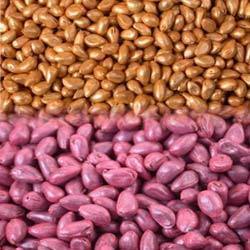
While the benefits to farmers are insignificant, the harm neonicotinoids cause to the wider environment is of serious concern. The dust kicked from planting coated seeds can drift off-field and contaminate field margins with high levels of these toxic pesticides. Indeed, the report cites findings that, depending on the crop, only five percent of the active chemical in a seed coating actually enters a crop. The other 95% of the chemical makes its way into the environment, either through seed dust, soil contamination, or water runoff. Just last month, Health Canada announced it would ban applications of the most widely used neonicotinoid, imidacloprid, as a result of dangers to aquatic life near agricultural fields. Neonics have been widely implicated as the most significant factor impacting the decline of pollinators around the globe. Effects range from acute toxicity and death, to chronic impacts such decreased memory and learning, inability for bees workers to find their way back to the hive, decreased queen fertility, and overall increased susceptibility of the colony to viruses, disease, and parasites.
Certain U.S. states are beginning to consider action to restrict the use of coated seeds. The state of Connecticut recently required the development of best management practices to avoid pesticide drift from dust kicked up during seed planting. And in Minnesota, where a recent executive order from Governor Dayton requires proof of a pest emergency before spraying foliar neonicotinoid applications, the Governor and Minnesota Department of Agriculture (MDA) also recommended legislation to give MDA the authority to regulate coated seeds. This was necessary because in the U.S., coated seeds are considered exempt articles under federal pesticide law (the federal fungicide insecticide and rodenticide act, or FIFRA). ¬† As such, they are not subject to the same protocols and regulations governing pesticide use. A recent lawsuit from CFS challenges this loophole in pesticide law, but a decision handed down late last month affirmed the exemption, indicating that, ‚ÄúThe Court is most sympathetic to the plight of our bee population and beekeepers. Perhaps the EPA should have done more to protect them‚Ä̬¶‚ÄĚ Thus, as EPA has so far showed its unwillingness to act to help bees and beekeepers, it is up to states and local governments to push for common-sense restrictions on these toxic products. The more local governments act, the more pressure it puts on EPA and the federal government to adequately address this crisis. After over a decade of year-after-year historic declines, it is only a matter of time before the true Net Loss of this crisis is revealed.
If you’re interested in doing more to become active in your community to stop and reverse pollinator declines, see Beyond Pesticides’ Bee Protective program page. Become educated on the science, and start your advocacy efforts by contacting Beyond Pesticides at 202-543-5450 or [email protected].
Source: Center for Food Safety
All unattributed positions and opinions in this piece are those of Beyond Pesticides.
Posted in Agriculture, Chemicals, Contamination, contamination, Genetic Engineering, Minnesota, neonicotinoids, Pesticide Regulation, Pesticide Residues by: Beyond Pesticides
No Comments
12
Dec
(Beyond Pesticides, ¬†December 12, 2016) ¬† On November 23, Bill Bader of ¬†Bader farms, Missouri‚Äôs largest peach farm with over 1,000 acres and 110,000 peach trees, filed a suit against the multinational, agrichemical giant Monsanto. Mr. Bader seeks compensation for extensive damags to his peach trees, which he blames on the illegal, or non-labeled, use of the toxic herbicide dicamba, brought on by sales of Monsanto’s new, genetically engineered (GE), dicamba-tolerant crops. Mr. Bader is projected to lose $1.5 million in revenue from the crop damage. The case was filed in the Circuit Court of Dunklin County, an area that has been hit especially hard by alleged illegal dicamba spraying. The farm’s insurance company refuses to cover damages from any illegal herbicide use. Without compensation for the damages, the farm risks going out of business. The illegal use of dicamba in this case is not an isolated incident. There have been many disputes in the Midwest over the ¬†illegal spraying of dicamba and subsequent crop damage due to pesticide drift. ¬†Numerous news reports over the past two ¬†months in southern soybean growing regions have found that many farmers are, in response to weeds on their farms that have become resistant to glyphosate (Roundup), illegally applying dicamba-based herbicide that are not labeled for use on Monsanto‚Äôs new GE crops.
The U.S. Department of Agriculture (USDA) deregulated Monsanto’s dicamba-tolerant Roundup Ready 2 Xtend√Ę‚Äě¬Ę ¬†soybeans and Bollgard II ¬ģXtendFlex√Ę‚Äě¬Ę cotton in January 2015. but it was not until November 2016 that the U.S. Environmental Protection Agency (EPA) registered the use of specific dicamba formulations, Xtendimax√Ę‚Äě¬Ę ¬† and VaporGrip√Ę‚Äě¬Ę for use these crops. Monsanto describes the dicamba-tolerant GE crops as “designed to provide farmers with more consistent, flexible control of weeds, especially tough-to-manage and glyphosate-resistant weeds ¬†to maximize crop yield potential.” What was viewed by industry and EPA several years ago as a unique occurrence, weed resistance is now acknowledged to be a serious economic problem for farmers. While the agrichemical industry and its researchers can no longer ignore weed resistance ¬†to pesticides, it continues to promote more chemical applications in GE crops as the solution, despite the success of organic systems.
Mr. Bader ¬†claims ¬†that dicamba, has killed more than 30,000 peach trees since 2015. ¬†Current dicamba formulations are extremely susceptible to pesticide drift. ¬†Dicamba is harmful even after it is deposited on target crops due to its ability to vaporize off leafy surfaces at moderate temperatures, where it is then reintroduced into the atmosphere. ¬†A ¬†study published by Pennsylvania State scientists ¬†in late 2015 found dicamba drift was ‚Äúfrequently responsible for sublethal, off-target damage‚ÄĚ to plants and insects. Researchers found that even very low rates of dicamba herbicide exposure negatively impacted plant flowering, and thus insect pollination. ¬†Increased illegal dicamba use is suspected to have been on the rise since 2015, when Monsanto released their new dicamba-resistant line of crops.
Monsanto’s previous herbicide of choice, Roundup,  has faced issues with weed resistance.  Over the years, weeds and undesirable vegetation have adapted and evolved to have a  genetic resistance to Roundup  and its active ingredient  glyphosate.  This led Monsanto to reformulate their seeds to be resistant to dicamba, which still shows effectiveness against weeds.  The herbicide formulations registered by are said to be less volatile and safer than previous dicamba formulations. Since Xtend crops were registered in 2015, this left a one year gap in which farmers were provided a new seed to cultivate with, yet left without a herbicide approved for use.  Many farmers, including Bill Bader, surmise that this led to the illegal, off-label use of other volatile dicamba formulations.
‚ÄúThe losses will certainly be in the millions,‚ÄĚ said Bev Randles of Randles & Splittgerber, a Kansas City law firm in a statement to St. Luois Post Dispatch. ¬†The impact of the damages to Bader‚Äôs farm are, ‚Äúmore long-term and farther-reaching,‚ÄĚ according to Randles. ¬†With Bader Farms expected to double its financial loses by next year, they predict the farm will be out of the peach business by 2019.
The lawsuit asserts that illegal spraying could have been more limited, if not prevented, had Monsanto not released the seeds before the subsequent herbicide XtendiMax was approved for use. ¬†‚ÄúThe issue here is one of ‚ÄĚňúforeseeability,‚Äô‚ÄĚ said Ms. Randles. ‚ÄúIt was entirely foreseeable that if Monsanto released the Xtend products onto the market that farmers would seek a way to protect those Xtend seeds from damage and they would do that by spraying dicamba.‚ÄĚ
Monsanto did take steps to notify and inform farmers before the 2016 growing season that the use of dicamba was not yet approved for in-crop use, and expressed that they do not condone the illegal use of any pesticide. ¬†Monsanto, in a recent statement, said the lawsuit, ‚Äúattempts to shift responsibility away from individuals who knowingly and intentionally broke state and federal law and harmed their neighbors in the process. Responsibility for these actions belongs to those individuals alone.‚ÄĚ
This is the first lawsuit that has been waged against Monsanto over illegal dicamba spraying, and is supported by Beyond Pesticides.  Dicamba  has been linked to damage of the kidney and liver, neurotoxicity, and developmental impacts.  While Missouri lawmakers  contemplate increasing fines  on illegal pesticide applications, ultimately, this problem will need to be addressed on a structural scale, as chemical-intensive farmers will need to diversify the crops they plant and implement other cultural practices to deter weeds, such as cover crops, crop rotation, and intercropping. Food distribution systems will also need to shift to accommodate greater diversity in farmer fields.  Organic agriculture  represents a time-tested approach to managing weeds and avoiding resistance problems that plague GE cropping systems. With organic, the use of toxic synthetic herbicides and GE seeds is prohibited, and farmers must craft an organic systems plan aimed at improving soil health and managing pests and weeds should they arise.
All unattributed positions and opinions in this piece are those of Beyond Pesticides.
Source:  St Louis Post Dispatch
Posted in 2,4-D, Agriculture, Alternatives/Organics, Chemicals, Contamination, contamination, Corporations, Dicamba, Environmental Justice, Farmworkers, Genetic Engineering, Glyphosate, Missouri, Monsanto, Pesticide Drift, Pesticide Regulation, State/Local by: Beyond Pesticides
No Comments
 According to OTA, the check-off creates an industry-funded promotion, research, and information program for certified organic products, whose overarching goal is to strengthen the position of certified organic products in the marketplace. OTA says this would be achieved by funding research to benefit the organic industry, improving access to information and data across the organic sector, and educating consumers about the benefits of organic, resulting in increased demand for organic products. Under the proposal, funds will be collected from certified organic farmers, handlers, and processors. The program will be led by a board of the same makeup from different geographic regions.
According to OTA, the check-off creates an industry-funded promotion, research, and information program for certified organic products, whose overarching goal is to strengthen the position of certified organic products in the marketplace. OTA says this would be achieved by funding research to benefit the organic industry, improving access to information and data across the organic sector, and educating consumers about the benefits of organic, resulting in increased demand for organic products. Under the proposal, funds will be collected from certified organic farmers, handlers, and processors. The program will be led by a board of the same makeup from different geographic regions.










 Canada, but declined dramatically in the 1990s.  Since then, their populations have dwindled and their overall decline is estimated at 91 percent. In its 
Canada, but declined dramatically in the 1990s.  Since then, their populations have dwindled and their overall decline is estimated at 91 percent. In its  .
.















 itely exposed one or more people (cases) to pesticides.‚ÄĚ The number of cases associated with non-agricultural pesticide use also increased, up 16% from 2013 for a total of 798 cases. Of those 798 cases, 34% of them were defined as occupational, meaning that they occurred while the affected people were at work. PISP also looked in injuries to agricultural field workers, finding that 148 workers were affected by pesticide exposure in 25 different episodes, with 40 being the largest number of workers injured at one time.
itely exposed one or more people (cases) to pesticides.‚ÄĚ The number of cases associated with non-agricultural pesticide use also increased, up 16% from 2013 for a total of 798 cases. Of those 798 cases, 34% of them were defined as occupational, meaning that they occurred while the affected people were at work. PISP also looked in injuries to agricultural field workers, finding that 148 workers were affected by pesticide exposure in 25 different episodes, with 40 being the largest number of workers injured at one time. s. As veteran reporter Cary Gillam notes in
s. As veteran reporter Cary Gillam notes in 




